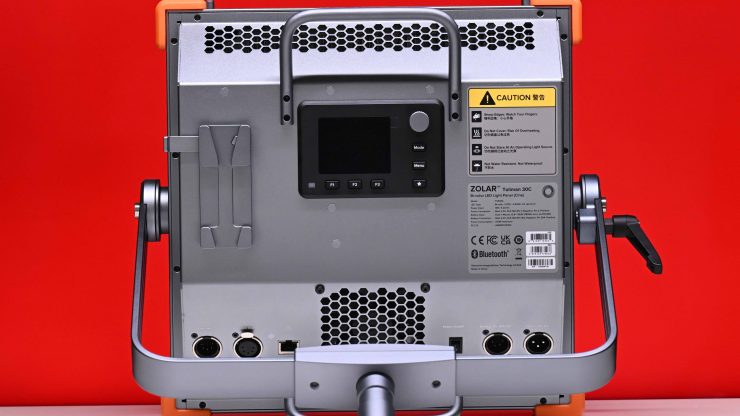
6 months ago I reviewed Z CAM’s new range of 1×1 LED fixtures, including the ZOLAR Vega 30C. Now, I recently updated the firmware so I wanted to see if there were any improvements to the color rendering scores.
If you want to see my very in-depth 10,000+ word long review of the Z CAM ZOLAR fixtures you can read it here.
I’ll come out and just say it, the ZOLAR Vega 30C is the best-performing, best-value 1×1 fixture on the market.
Just as a refresher, here are the basic features of the ZOLAR Vega 30C.
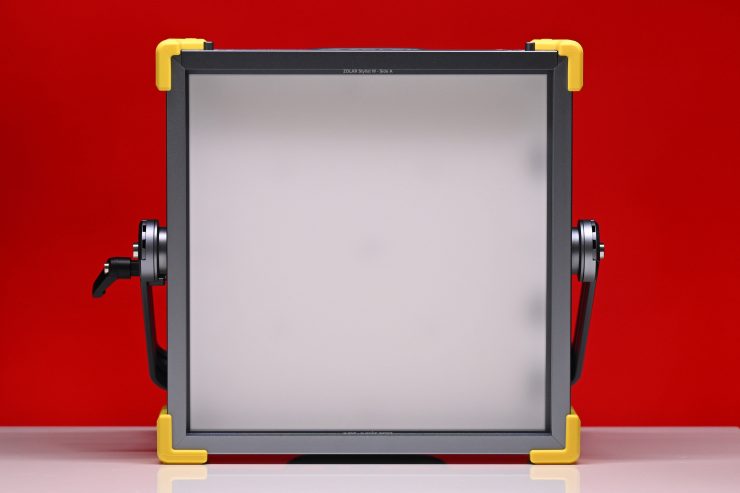
The Vega 30C is a Full RGBAW Color Gamut 1×1 panel with a CCT range of 2,000K to 20,000K. It also features built-in effects, gels, and source matching. It also has full +/- G/M.
The Vega is a 5-color LED light panel series targeting professional video productions. It was designed with 5-color full spectrum LEDs and RGBAW algorithm to deliver continuous light spectrum across full CCT range with exceptionally high CRI & TLCI scores, particularly in R9, R12, R13 & R15.
Key features
- CRI: Ra≥97 (R9 & R12 up to 97), TLCI≥98
- Spectral Similarity Index SSI up to 90
- Full RGBAW Color Gamut
- CCT range: 2,000K ~ 20,000K
- DMX, Art-Net 4 & sACN + powerCON
- ZOLAR Stylist precision directional super light transmissible panel: control beam angle, light diffusion, no color shift
- Multi Light Sync – ZolarLink (wireless / cable), rapid auto sync grouping
- Built in Light Effect (synchronized) for different scene applications;
- Bluetooth + WiFi mixed control: Remote Controller, mobile app (iOS & Android).
When I originally reviewed the Z CAM ZOLAR Vega 30C I found that its color rendering scores were exceptionally good.
Z CAM has been hard at work behind the scenes and they have found a way of improving the color rendering through a firmware update. Now, I don’t expect any huge differences, because the light running the original firmware was already so good. However, I am going to do my due diligence and re-test the light so you can see for yourself if any improvements have been made. I will show you the test results from my original readings and compare them against the updated results from the firmware update.
Output & CCT Accuracy
I tested the ZOLAR Vega 30C at a variety of CCT settings with a Sekonic C-800 Spectrometer to find out how much output the light had and how accurate the CCT reproduction was. All readings are taken at a distance of 1m (3.28ft) in a controlled environment.
First, let’s look at the previous results when the light was used at 5600K.
5600K
ZOLAR Vega 30C (Stylist W Side A) High Color Mode (ORIGINAL FIRMWARE)
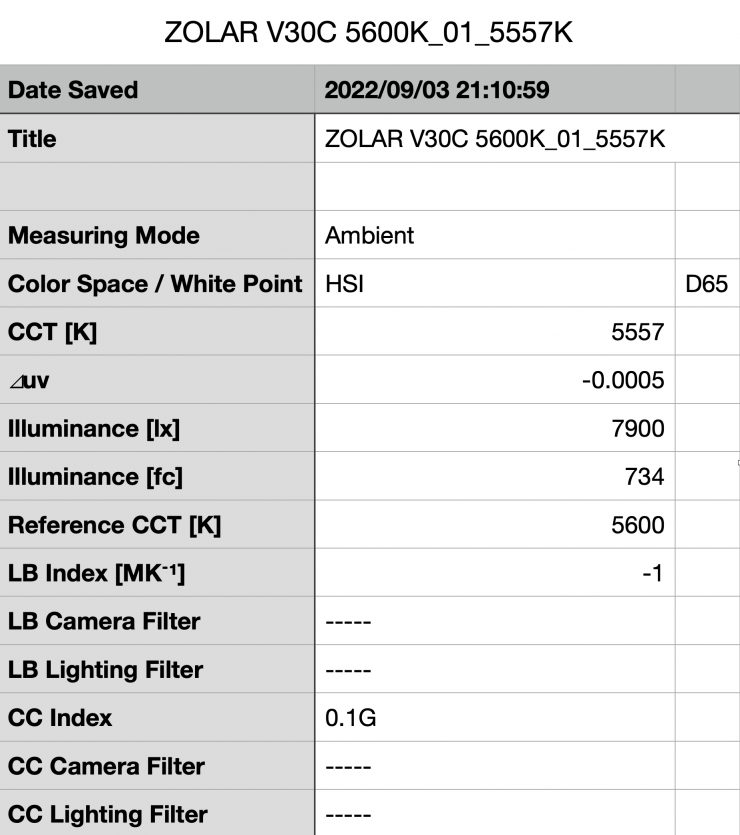
Above you can see that with the original firmware, the Vega 30C recorded an output of 7900 lx (734 fc) when set at 5600K with its Stylist W diffusion panel (side A) and run via mains power in its High Color mode.
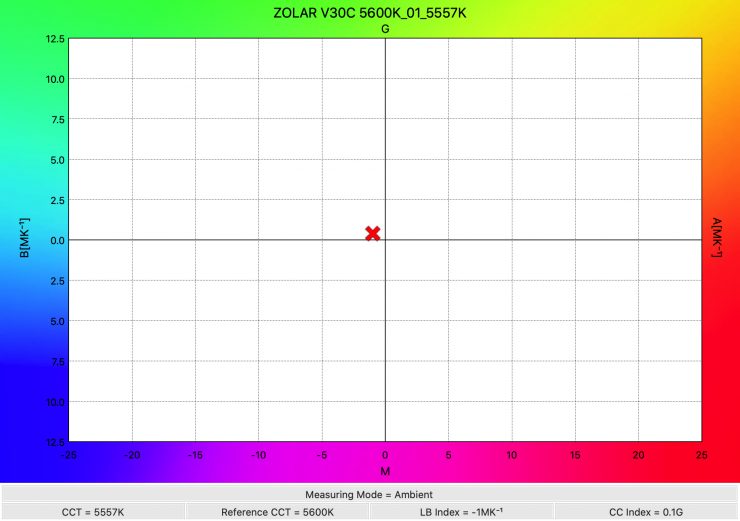
The light recorded a CCT of 5557K which was very accurate.
ZOLAR Vega 30C (Stylist W Side A) High Color Mode (NEW FIRMWARE)
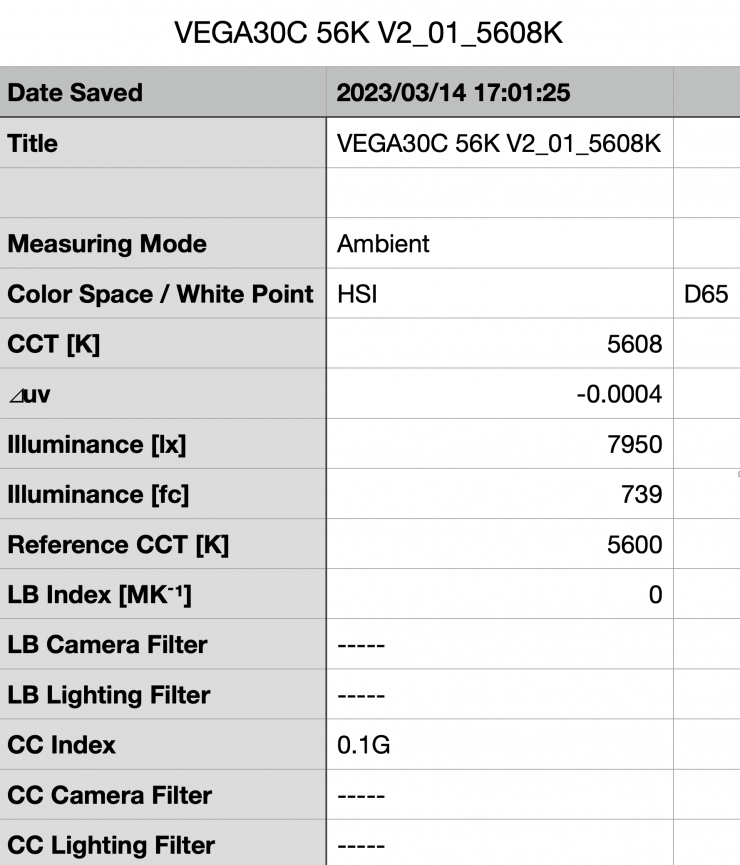
Above you can see that with the new firmware, the Vega 30C recorded an output of 7950 lx (739 fc) when set at 5600K with its Stylist W diffusion panel (side A) and run via mains power in its High Color mode. This was 50 lx higher than the reading I obtained using the original firmware.
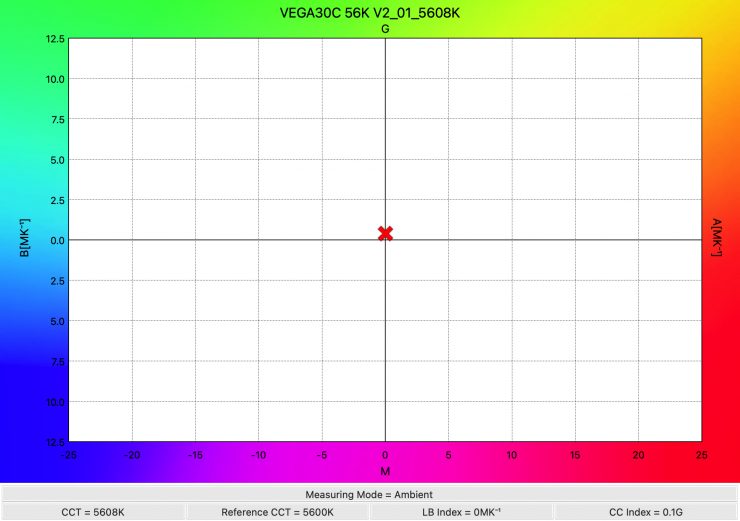
The light recorded a CCT of 5608K which was extremely accurate. and better than the 5557K it recorded with the original firmware.
3200K
ZOLAR Vega 30C (Stylist W Side A) High Color Mode (ORIGINAL FIRMWARE)
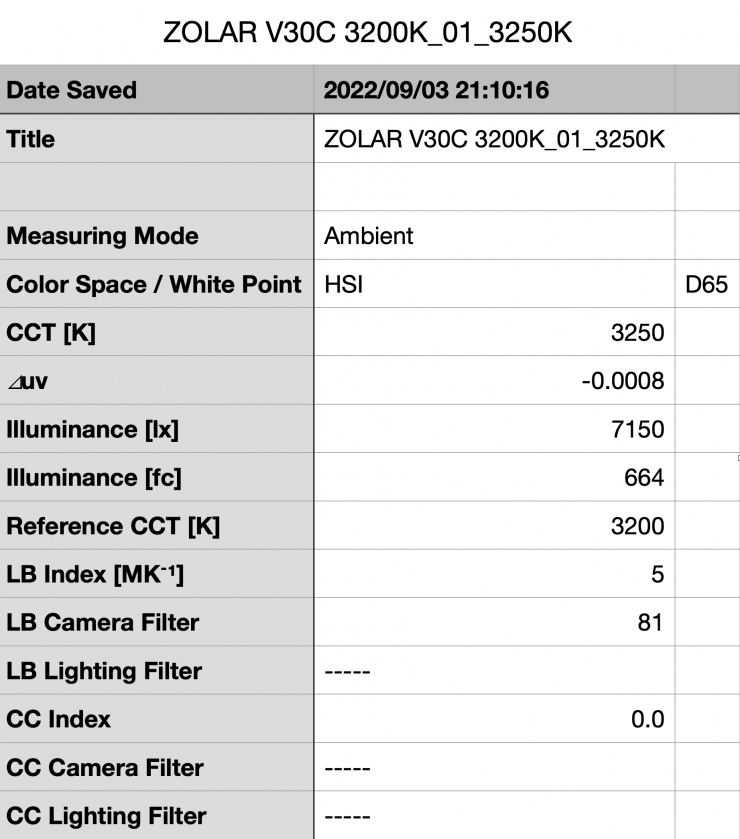
Above you can see that with the original firmware, the Vega 30C recorded an output of 7150 lx (664 fc) when set at 5600K with its Stylist W diffusion panel (side A) and run via mains power in its High Color mode.
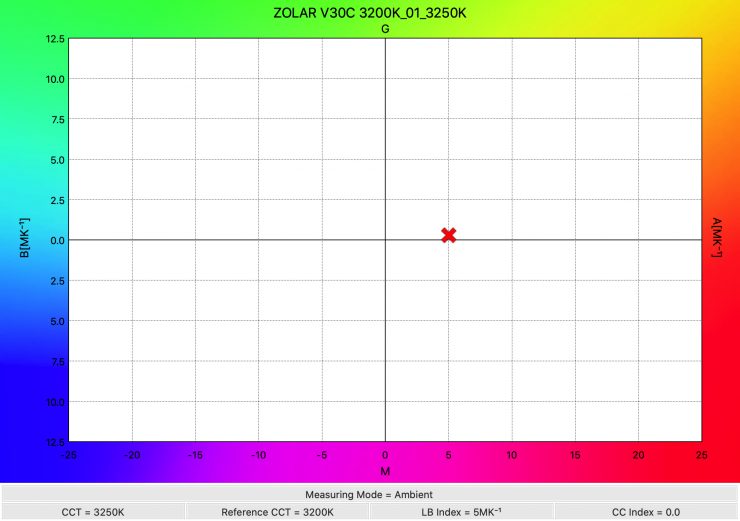
The Vega 30C produced a CCT reading of 3250K which was a good score.
ZOLAR Vega 30C (Stylist W Side A) High Color Mode (NEW FIRMWARE)
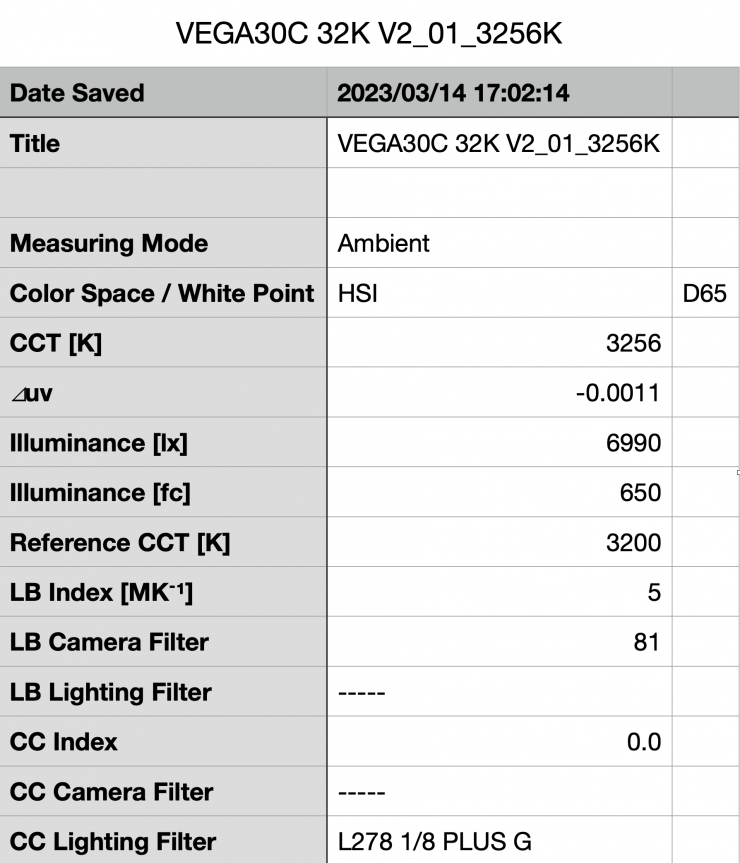
Above you can see that with the new firmware, the Vega 30C recorded an output of 6990 lx (650 fc) when set at 5600K with its Stylist W diffusion panel (side A) and run via mains power in its High Color mode. This was 160 lx less than it had with the original firmware.
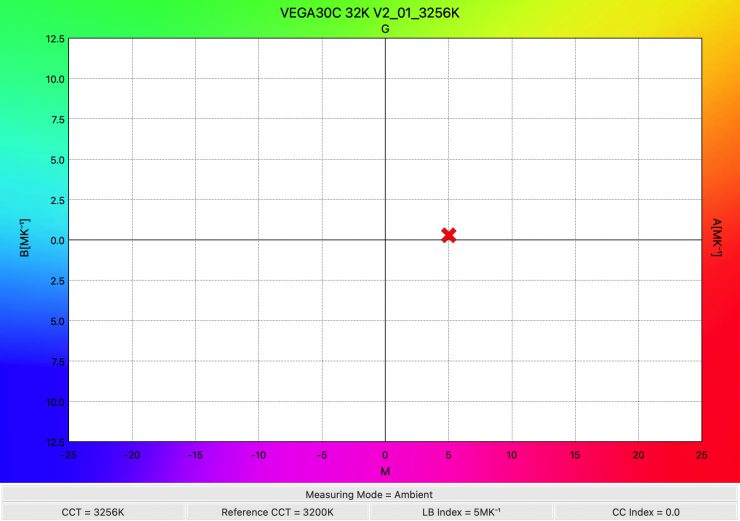
With the new firmware, the Vega 30C produced a CCT reading of 3256K which was a good score and almost identical to the 3250K it recorded with the old firmware.
| KELVIN SETTING | LUX | CCT READING |
| 2500K | 6720 lx | 2638K |
| 3200K | 7150 lx | 3250K |
| 4500K | 7810 lx | 4490K |
| 5600K | 7900 lx | 5557K |
| 6500K | 7430 lx | 6403K |
| 8000K | 6890 lx | 8004K |
| 10000K | 6540 lx | 9709K |
These results tell me that the light has excellent CCT accuracy across its range, however, it is at its most accurate when used between 3200-8000K. The output varies by 20.8% from the highest to lowest recorded readings.
ZOLAR Vega 30C (Stylist W Side A) High Color Mode (New Firmware)
| KELVIN SETTING | LUX | CCT READING |
| 2500K | 6770 lx | 2578K |
| 3200K | 6990 lx | 3256K |
| 4500K | 7970 lx | 4542K |
| 5600K | 7950 lx | 5608K |
| 6500K | 7590 lx | 6489K |
| 8000K | 7030 lx | 8135K |
| 10000K | 6670 lx | 9895K |
These results with the new firmware were better than the results I obtained using the original firmware. There was an improvement in CCT accuracy and output at almost every CCT setting. The CCT reading was no more than 135K being correct at any setting that was tested. The output varies by 19.49% from the highest to lowest recorded readings.
Color Rendering
So now that we have seen how much output the light produces, how does it perform when it comes to replicating accurate colors? Well, let’s first have a look at the light when it is used at 5600K.
5600K
ZOLAR Vega 30C (Stylist W Side A) High Color Mode 5600K (Original Firmware)
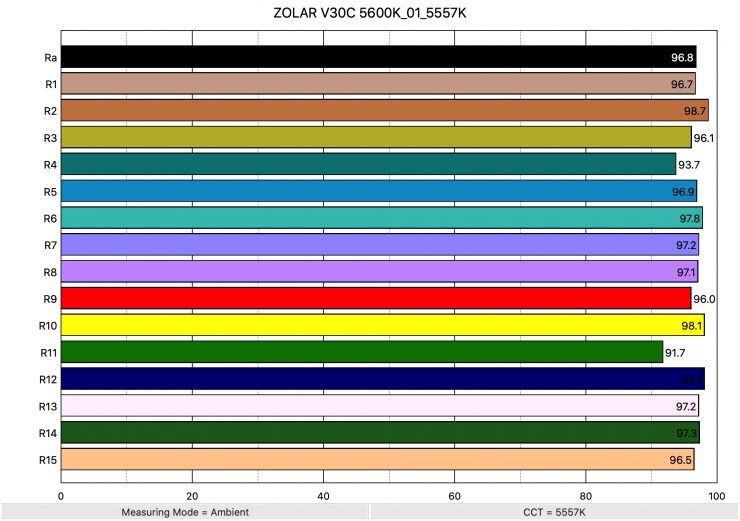
Above you can see that when the Vega 30C when using the original firmware and set at 5600K in its High Color mode recorded an average CRI (R1-R8) of 96.8 and an extended CRI (R1-R15) of 96.60. For replicating accurate skin tones it recorded 96.0 for R9 (red), 97.2 for R13 (closest to caucasian skin tones), and 96.5 for R15 (closest to Asian skin tones).
Every single value from R1-R15 was above 90.
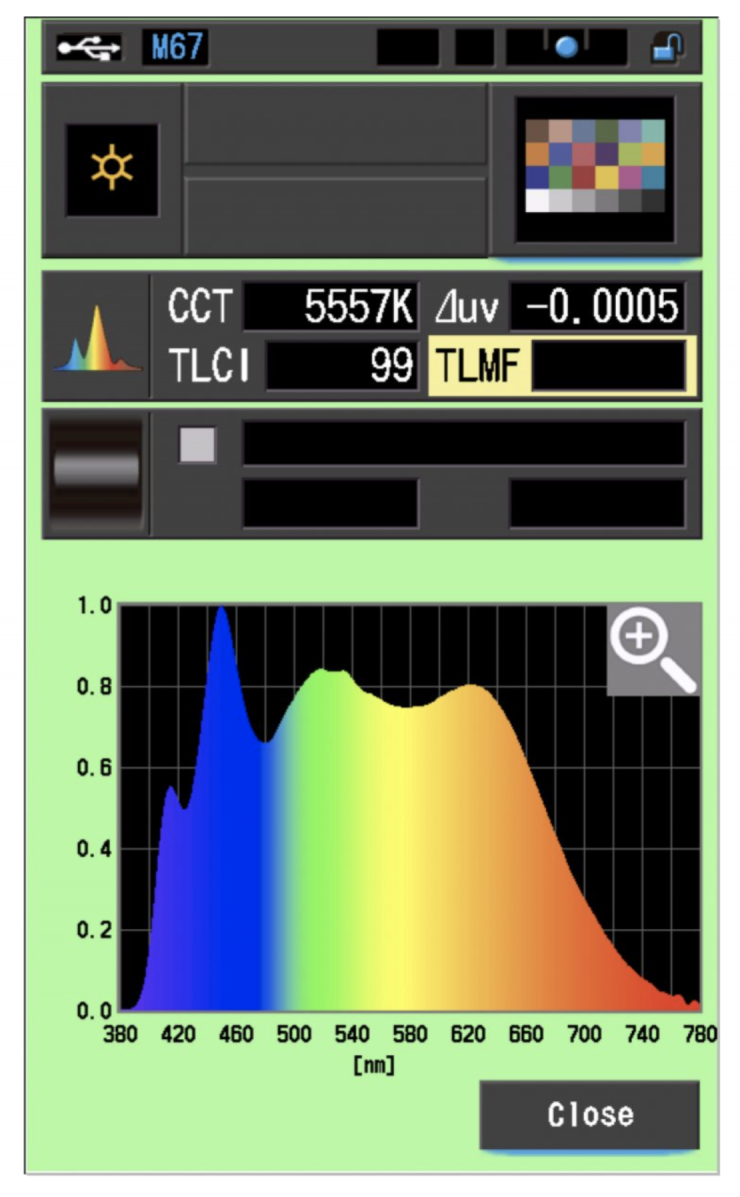
With the old firmware, the Vega 30C recorded a near-perfect TLCI score of 99.
ZOLAR Vega 30C (Stylist W Side A) High Color Mode 5600K (New Firmware)
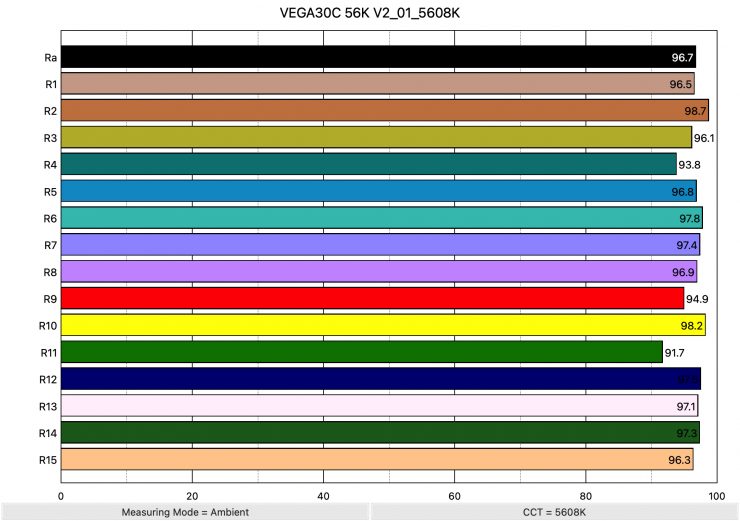
Above you can see that when the Vega 30C when using its new firmware and set at 5600K in its High Color mode recorded an average CRI (R1-R8) of 96.7 and an extended CRI (R1-R15) of 96.47. For replicating accurate skin tones it recorded 94.9 for R9 (red), 97.1 for R13 (closest to caucasian skin tones), and 96.3 for R15 (closest to Asian skin tones).
Every single value from R1-R15 was above 90. Ok, so no real changes here, most of the scores are almost exactly the same or very close to the light running the original firmware.
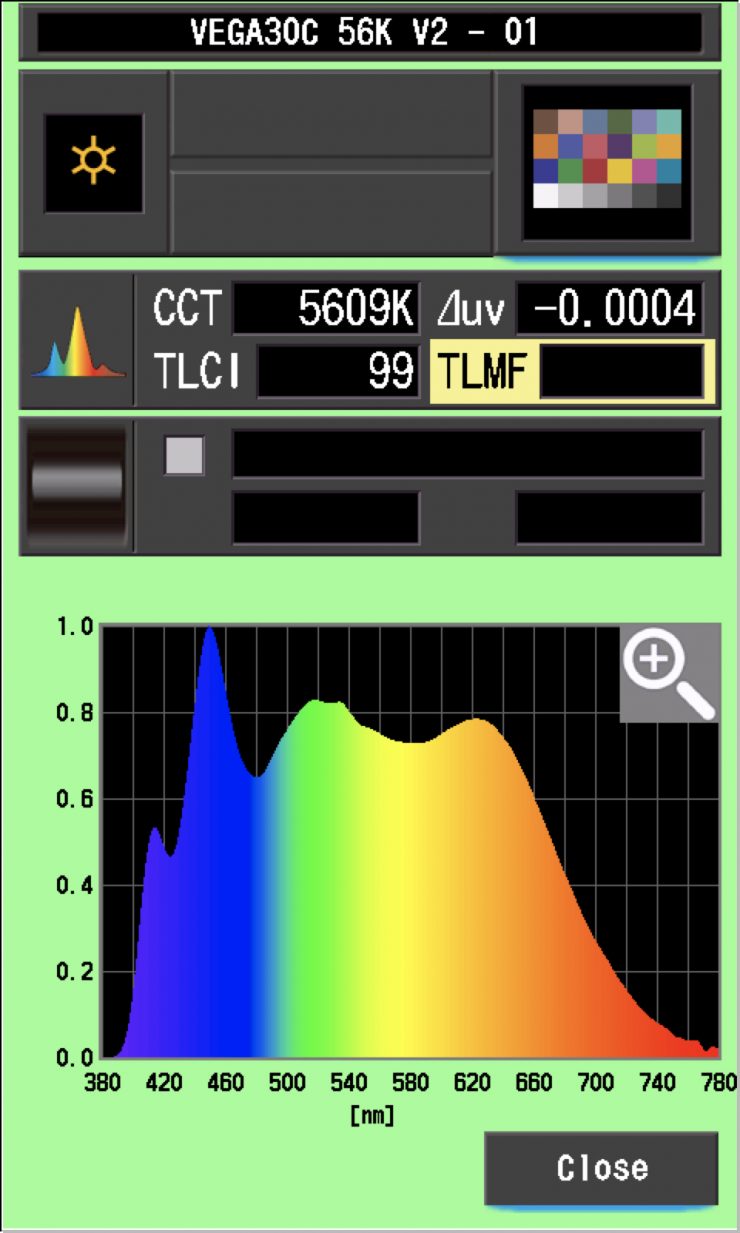
With the new firmware, the Vega 30C recorded a near-perfect TLCI score of 99. This was exactly the same result as when using the old firmware.
So, let’s move on to 3200K.
3200K
ZOLAR Vega 30C (Stylist W Side A) High Color Mode 3200K (Original Firmware)
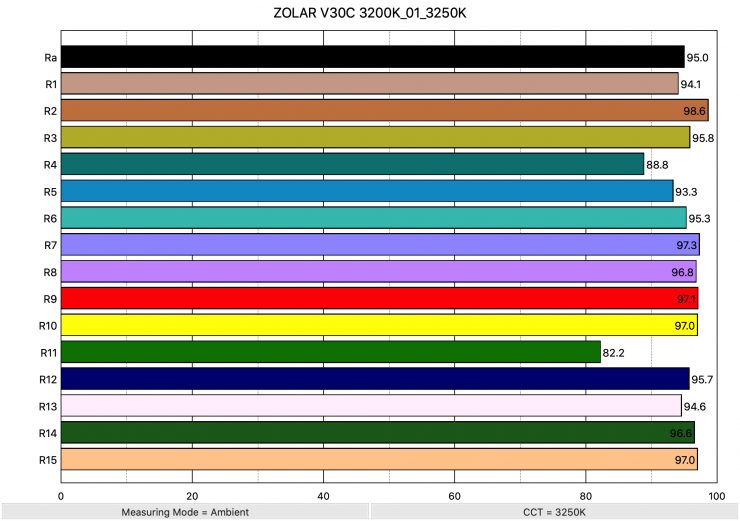
Above you can see that when the Vega 30C was set at 3200K in its High Color mode and used with its original firmware it recorded an average CRI (R1-R8) of 95.0 and an extended CRI (R1-R15) of 94.68. For replicating accurate skin tones it recorded 97.1 for R9 (red), 94.6 for R13 (closest to caucasian skin tones), and 97.0 for R15 (closest to Asian skin tones).
These were great results, but unlike at 5600K, the light had both R4 and R11 scores below 90.
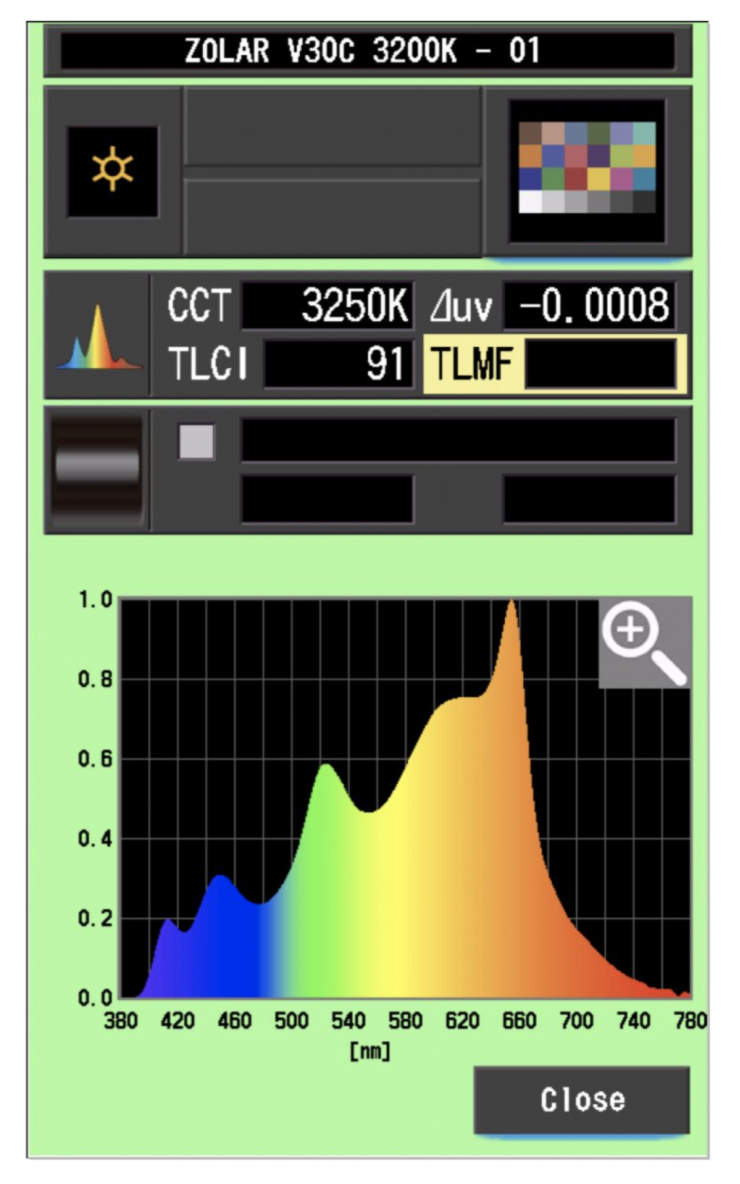
Above you can see that the Vega 30C had a TLCI score of just 91 when used at 3200K. This was a low score, but the tests don’t lie
ZOLAR Vega 30C (Stylist W Side A) High Color Mode 3200K (New Firmware)
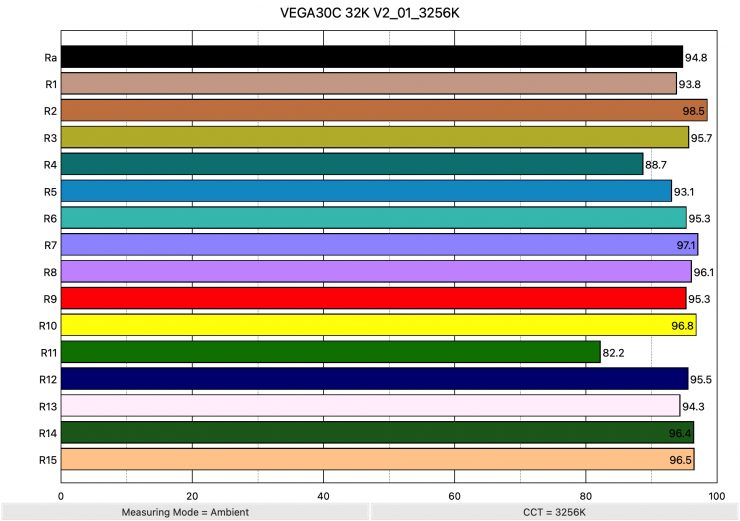
Above you can see that when the Vega 30C was set at 3200K in its High Color mode and used with its new firmware it recorded an average CRI (R1-R8) of 94.8 and an extended CRI (R1-R15) of 94.24. For replicating accurate skin tones it recorded 95.3 for R9 (red), 94.3 for R13 (closest to caucasian skin tones), and 95.5 for R15 (closest to Asian skin tones).
These were good results, but they weren’t quite as good as I recorded with the original firmware. In saying that they were extremely similar.
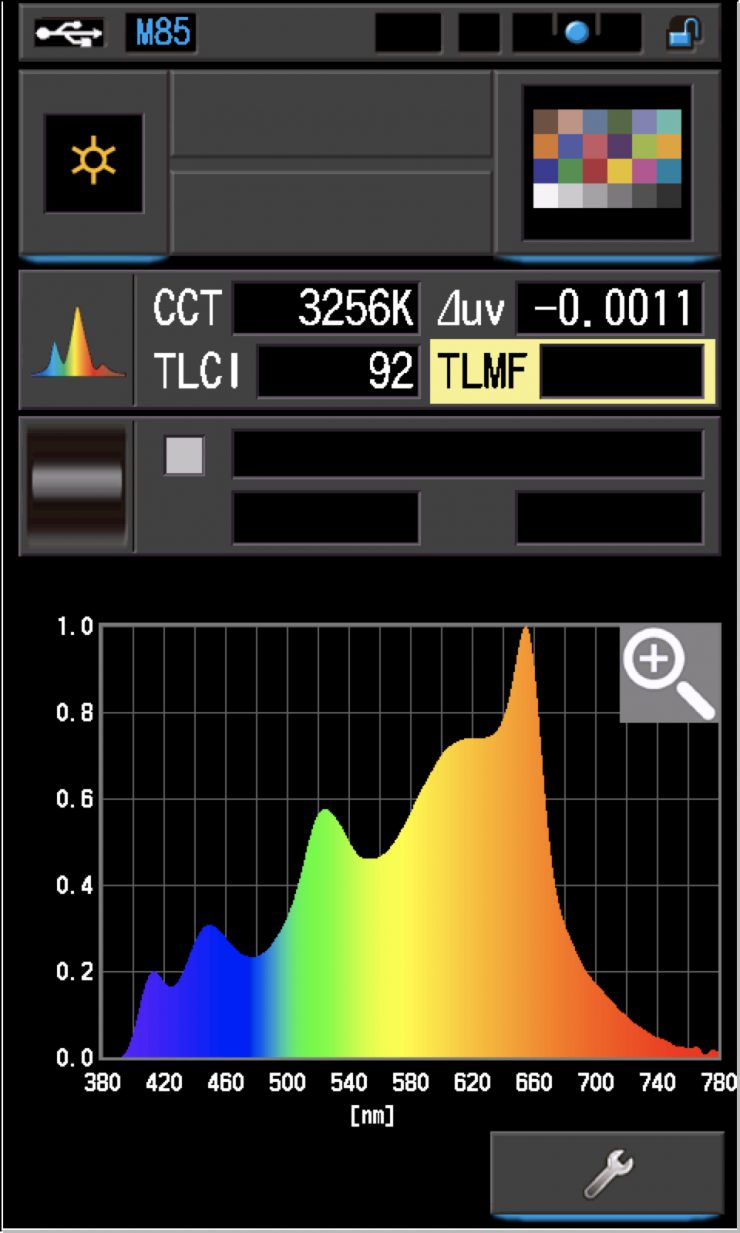
Above you can see that the Vega 30C when running the new firmware had a TLCI score of just 92 when used at 3200K. This was a low score and only 1 higher than the 91 it recorded when using the old firmware.
CC Index & ⊿uv
The CC Index displays the CC correction value and whether any magenta or green needs to be added or subtracted. 1 CC corresponds to 035 Kodak CC values or 1/8 Rosco filter values. Any reading less than +1.00 or -1.00 and you’re probably not going to need to make any kind of adjustment. The ⊿uv is the value to show how much this light is away from being an ideal light source (black body radiation = incandescent lamp). As with the CC Index you want this number to theoretically be zero. Kelvin is not a linear value, so we need to convert from Kelvin to MK-1 to compare the values of color temperature. To calculate from Kelvin to Mired is MK-1= 1*1000000/Kelvin. While this may sound confusing, it is the only way of measuring if the Kelvin shift is significant enough to warrant having to use a filter for correction. Below are the results for the ZOLAR Vega 30C pre and post-firmware update.
ZOLAR Vega 30C Kelvin Vs MK-1 (original firmware)
| CCT | Difference in K | MK-1 | Difference in MK-1 | |
| SET VALUE | 2500K | 0 | 400 | 0 |
| ACTUAL READING | 2638K | 138 | 359.06 | 40.94 MK-1 |
| SET VALUE | 3200K | 0 | 312.5 | 0 |
| ACTUAL READING | 3250K | 50 | 307.69 | 4.81 MK-1 |
| SET VALUE | 4500K | 0 | 222.22 | 0 |
| ACTUAL READING | 4460K | 40 | 224.21 | -1.99 MK-1 |
| SET VALUE | 5600K | 0 | 178.57 | 0 |
| ACTUAL READING | 5443K | 31 | 183.72 | -5.15 MK-1 |
| SET VALUE | 6500K | 0 | 153.84 | 0 |
| ACTUAL READING | 6403K | 97 | 156.17 | -2.33 MK-1 |
| SET VALUE | 8000K | 0 | 125 | 0 |
| ACTUAL READING | 8004K | 4 | 124.93 | 0.07 MK-1 |
| SET VALUE | 10000K | 0 | 100.00 | 0 |
| ACTUAL READING | 9709K | 291 | 102.99 | -2.99 MK-1 |
With the original firmware, the light was extremely CCT-accurate at all temperatures except for 2500K. Any MK-1 score that is under -9/9 means you wouldn’t have to use any color correction gels. The MK-1 scores for this light were very good.
ZOLAR Vega 30C Kelvin Vs MK-1 (New firmware)
| CCT | Difference in K | MK-1 | Difference in MK-1 | |
| SET VALUE | 2500K | 0 | 400 | 0 |
| ACTUAL READING | 2578K | 78 | 387.89 | 12.11 MK-1 |
| SET VALUE | 3200K | 0 | 312.5 | 0 |
| ACTUAL READING | 3256K | 56 | 307.12 | 5.03 MK-1 |
| SET VALUE | 4500K | 0 | 222.22 | 0 |
| ACTUAL READING | 4542K | 58 | 220.16 | 2.06 MK-1 |
| SET VALUE | 5600K | 0 | 178.57 | 0 |
| ACTUAL READING | 5608K | 8 | 178.31 | 0.26 MK-1 |
| SET VALUE | 6500K | 0 | 153.84 | 0 |
| ACTUAL READING | 6489K | 11 | 154.10 | -0.26 MK-1 |
| SET VALUE | 8000K | 0 | 125 | 0 |
| ACTUAL READING | 8135K | 135 | 122.92 | 2.08 MK-1 |
| SET VALUE | 10000K | 0 | 100.00 | 0 |
| ACTUAL READING | 9895K | 105 | 101.06 | -1.06 MK-1 |
With the new firmware, the light scored even better at most CCT settings. light is exceptionally CCT-accurate at 4500K and above. at 5600K and 6500K it had almost perfect MK-1 scores. Any MK-1 score that is under -9/9 means you wouldn’t have to use any color correction gels. The MK-1 scores for this light were outstanding. Even at 2500K it improved from a score of 40.94 MK-1 with the old firmware down to 12.11 MK-1 with the new firmware.
ZOLAR Vega 30C CC INDEX & ⊿uv (Original Firmware)
| CC INDEX | ⊿uv | |
| 2500K | 0.2G | -0.0009 |
| 3200K | 0 | -0.0008 |
| 4500K | 0 | -0.0001 |
| 5600K | 0.1G | -0.0005 |
| 6500K | 0.2G | 0.0003 |
| 8000K | 0.6G | -0.0008 |
| 10000K | 0.9G | -0.0004 |
With the old firmware, the light had accurate ⊿uv scores across the light’s entire CCT range. The light’s CC INDEX scores were excellent from 2500K to 6500K. At 8000K and above it does start to shift, but you don’t have to worry about it unless it is above 1.0.
ZOLAR Vega 30C CC INDEX & ⊿uv (New Firmware)
| CC INDEX | ⊿uv | |
| 2500K | 0.2G | -0.0010 |
| 3200K | 0 | -0.0011 |
| 4500K | 0 | 0.0000 |
| 5600K | 0.1G | -0.0004 |
| 6500K | 0.2G | 0.0003 |
| 8000K | 0.6G | -0.0006 |
| 10000K | 0.9G | -0.0002 |
With the new firmware, the scores were exceptionally good. In fact, these were the best collection of scores I have seen from a light, period. As you can see the ⊿uv score at 4500K was perfect, and at 5600K, 6500K, 8000K, and 10,000K it was very close to being perfect. The light’s CC INDEX scores were excellent from 2500K to 6500K. At 8000K and above it does start to shift, but you don’t have to worry about it unless it is above 1.0.
TM-30
TM-30 is a relatively new color rendering standard that was developed to deal with the limitations of CRI. TM-30 looks at 99 individual colors. These 99 colors are categorized into seven groups: nature, skin color, textiles, paints, plastics, printed material, and color systems.
TM-30 scores go from 0 – 100. The higher the score, the more accurate a light is at producing colors. Any TM-30 Rf score in the ’90s is considered to be good. What is interesting and something that you need to be very aware of is that two separate light sources with the exact same CRI scores can render colors very differently. A light with a high CRI rating could have a low TM-30 score. Conversely, a light with a good TM-30 score could have a bad CRI score.
Now, there are two measurements associated with TM-30, Rf and Rg.
Rf (Color Fidelity)
Rg (Color Gamut)
With Rf value, ideally, you want a score in the 90’s.
With Rg value, a score below 100 indicates that the light source renders colors with less saturation than the reference source. So ideally you want this score to be above 100.
ZOLAR Vega 30C (Original Firmware)
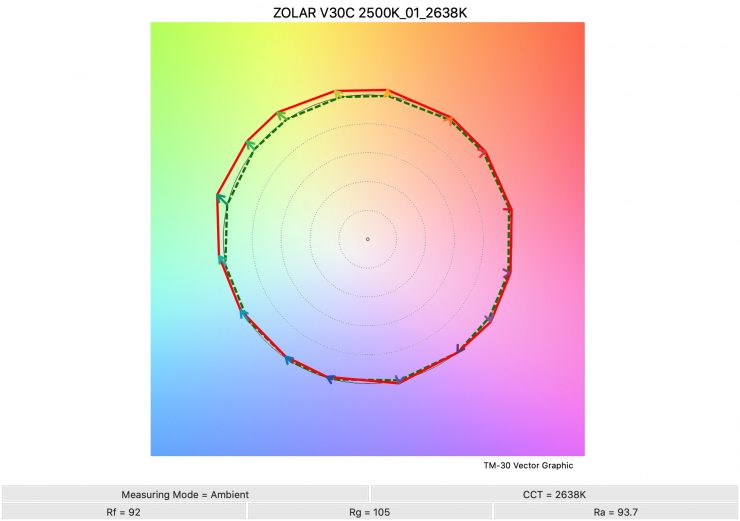
2500K 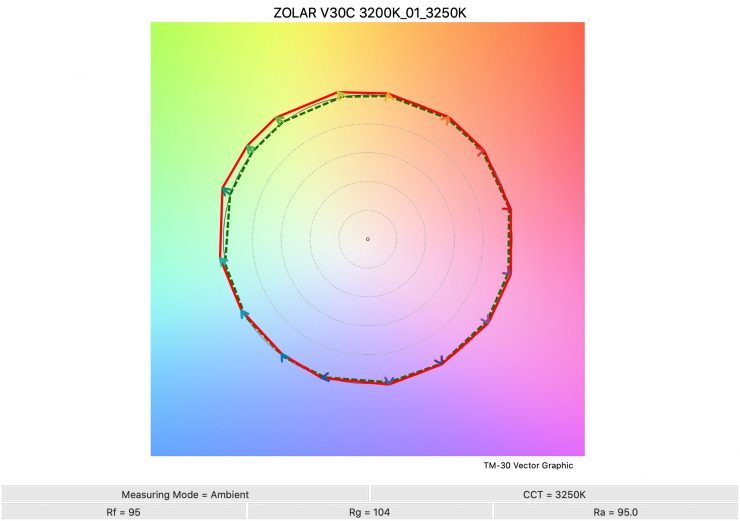
3200K 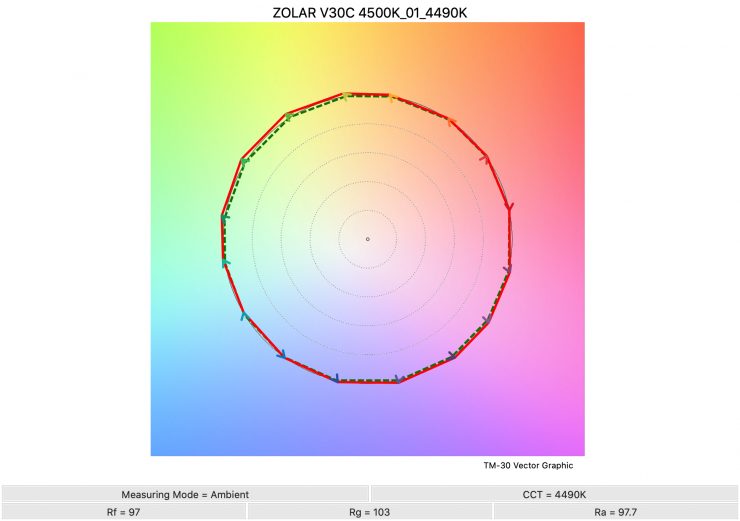
4500K 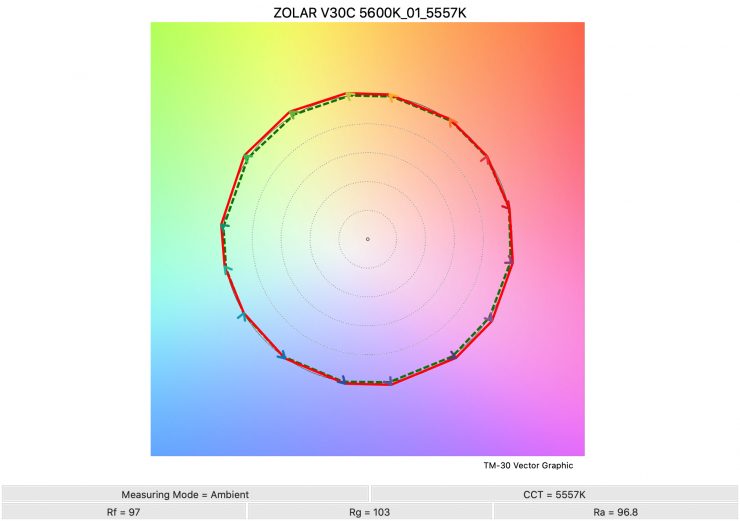
5600K 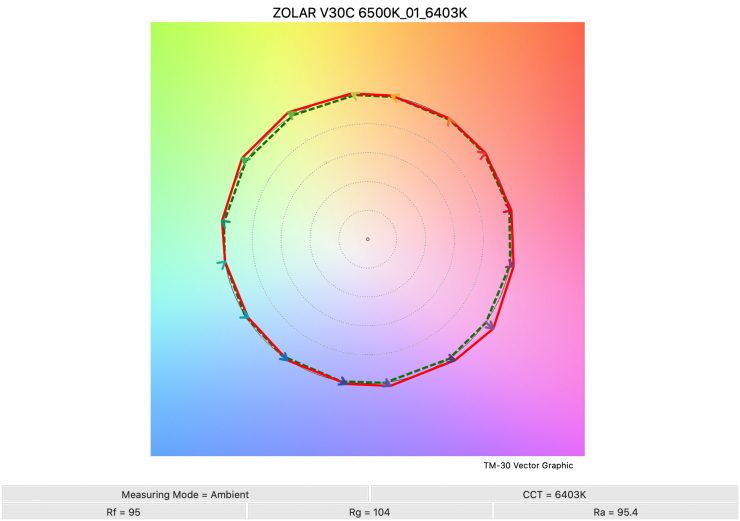
6500K 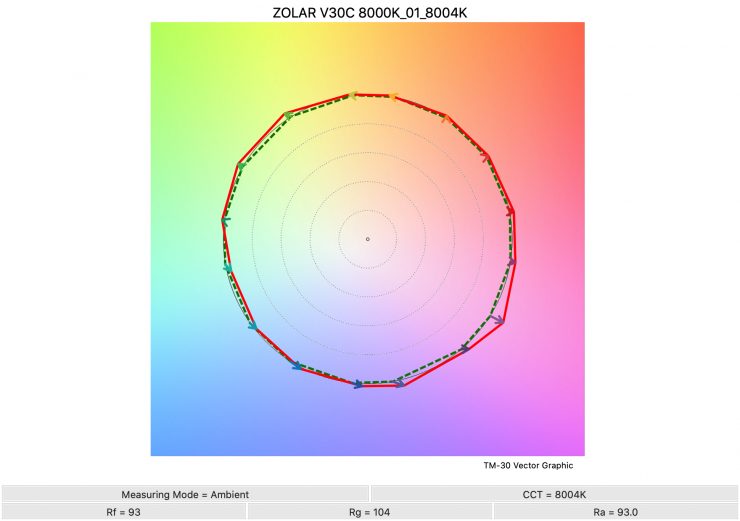
8000K 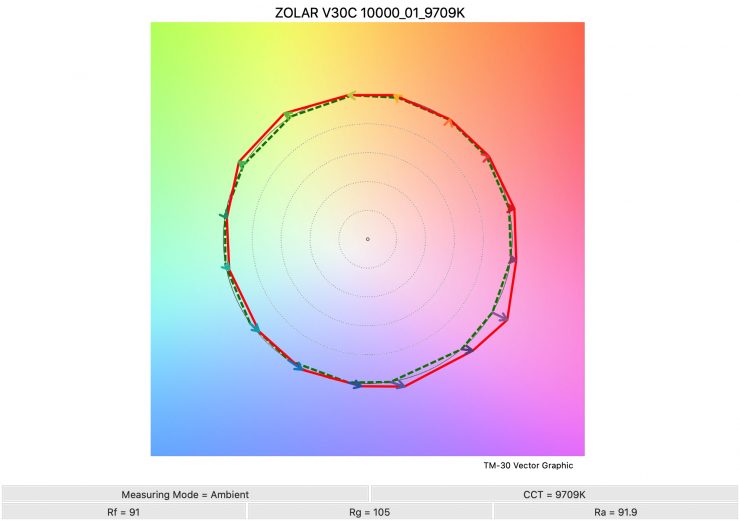
10000K
Above you can see the scores for the Vega 30C at various Kelvin color temperatures. Below I have listed the figures as well.
| Rf | Rg | |
| 2500K | 92 | 105 |
| 3200K | 95 | 104 |
| 4500K | 97 | 103 |
| 5600K | 97 | 103 |
| 6500K | 95 | 104 |
| 8000K | 93 | 104 |
| 10000K | 91 | 105 |
The TM-30 scores are all good and the light is pretty consistent at replicating accurate colors with full saturation.
ZOLAR Vega 30C (New Firmware)
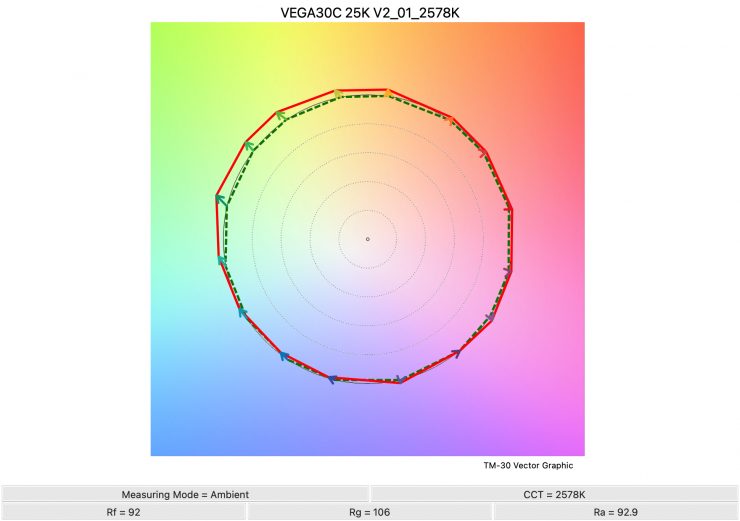
2500K 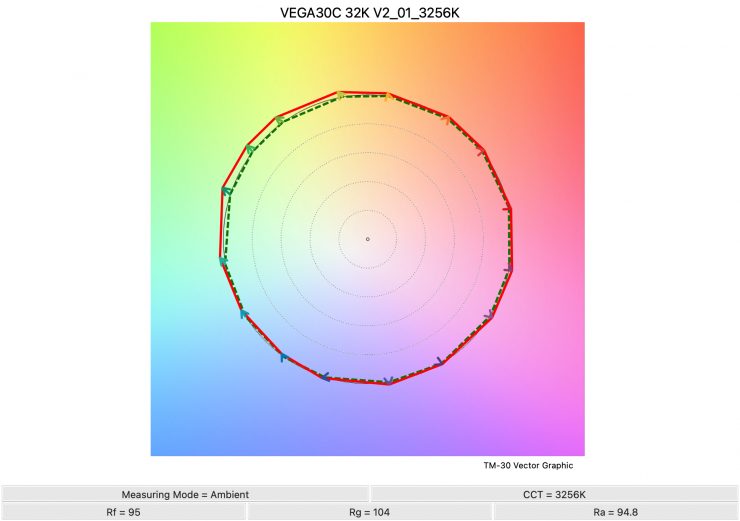
3200K 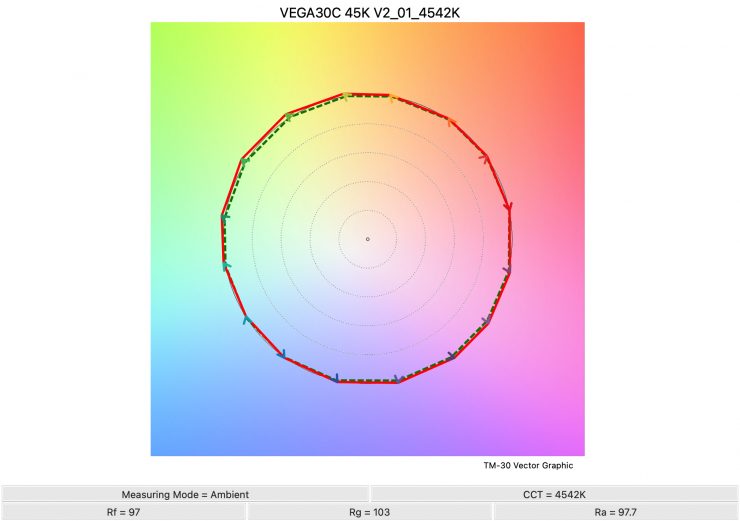
4500K 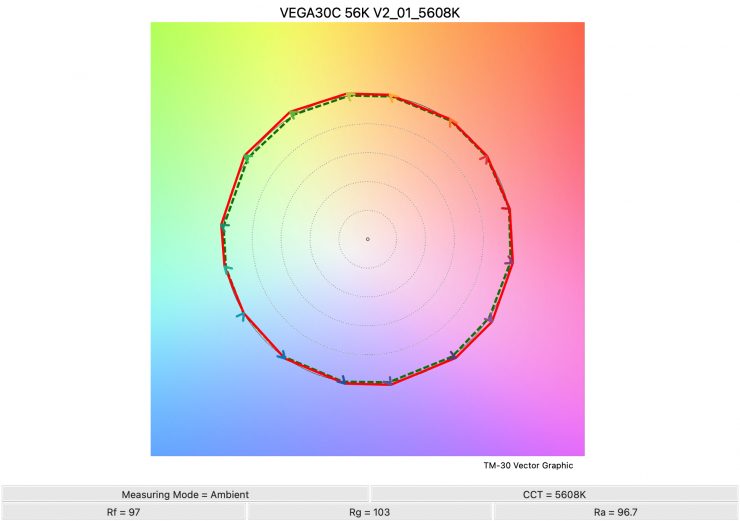
5600K 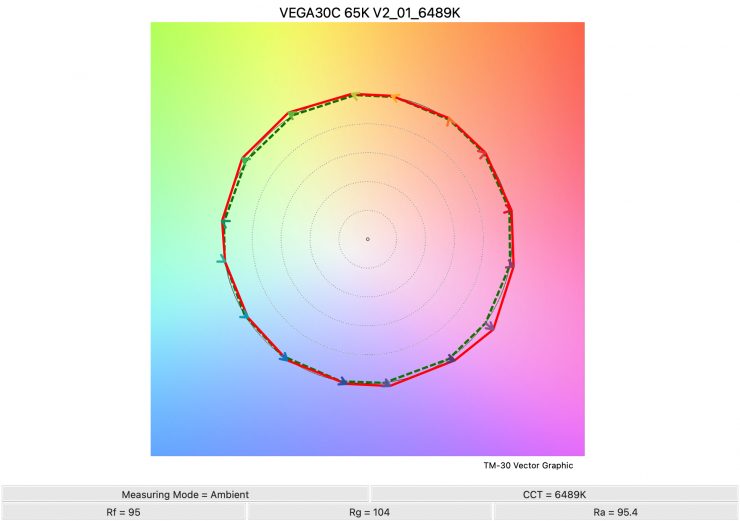
6500K 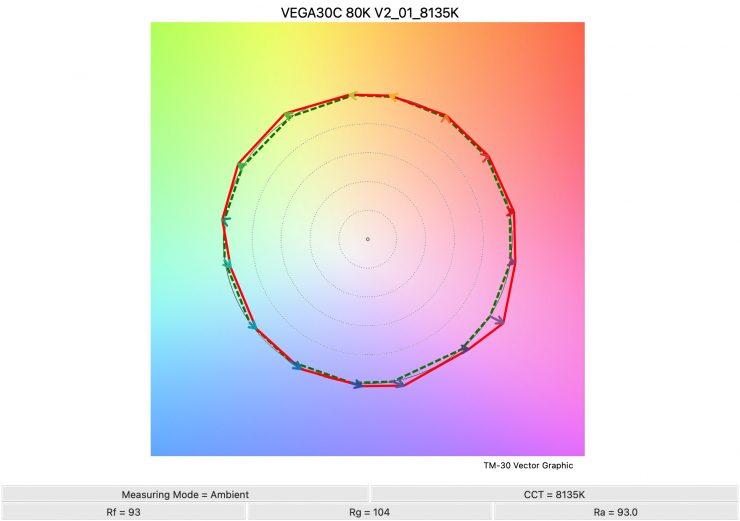
8000K 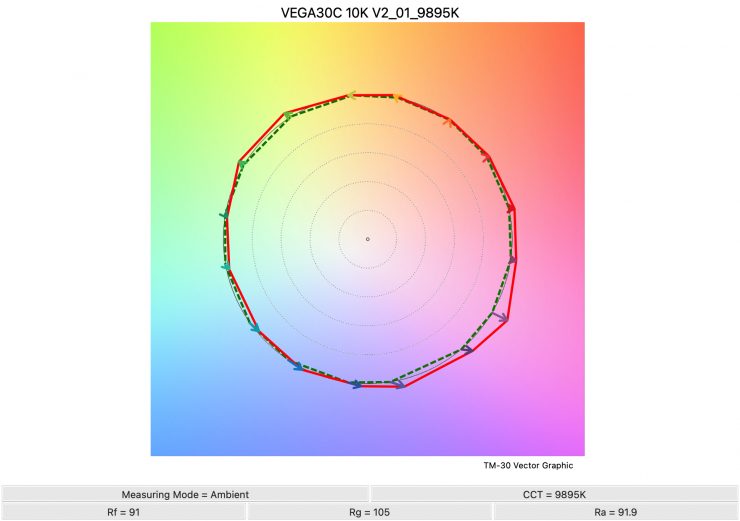
10000K
Above you can see the scores for the Vega 30C at various Kelvin color temperatures. Below I have listed the figures as well.
| Rf | Rg | |
| 2500K | 92 | 106 |
| 3200K | 95 | 104 |
| 4500K | 97 | 103 |
| 5600K | 97 | 103 |
| 6500K | 95 | 104 |
| 8000K | 93 | 104 |
| 10000K | 91 | 105 |
The TM-30 scores with the new firmware were identical to those of the old firmware. These results show me that the light is pretty consistent at replicating accurate colors with full saturation.
SSI
SSI (Spectral Similarity Index) was developed by the Sci-Tech Council of the Academy. SSI gives me the ability to set any light as a standard, or use predefined standards (such as CIE D55), and then give other lights an SSI score based upon how well they will match standards such as CIE D55. This way I can measure spectral response and compare it directly against an ideal light source. This is actually a much better test than recording CRI scores.
First, let’s look at 3200K.
3200K
ZOLAR Vega 30C 3200K (Original firmware)
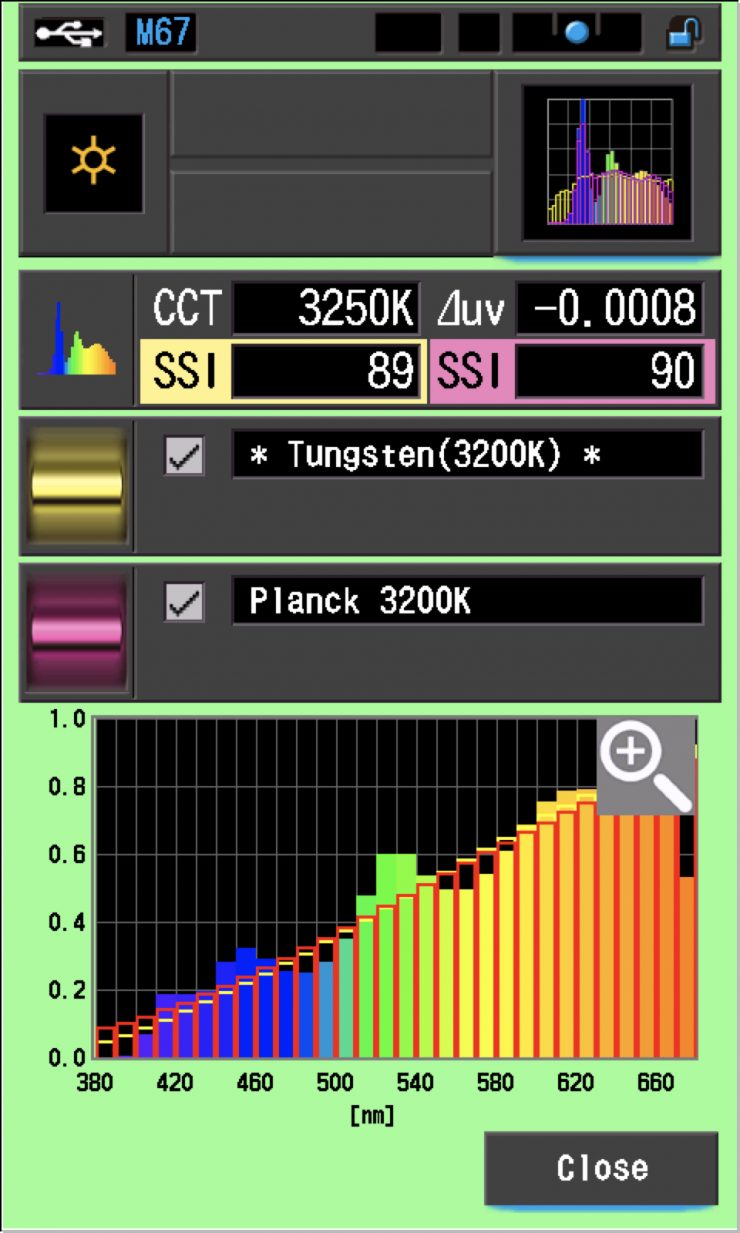
In this graph, the red bars indicate a perfect Planck 3200K source. The gold bars indicate a perfect 3200K Tungsten source. This lets us compare how close to a perfect 3200K lighting source the Vega 30C is. Any SSI score in the low ’80s is very good for a 3200K LED light, however, the Vega 30C scores were 89 and 90 respectively. These are the best SSI scores I have seen for any LED light when used at 3200K.
ZOLAR Vega 30C 3200K (New firmware)
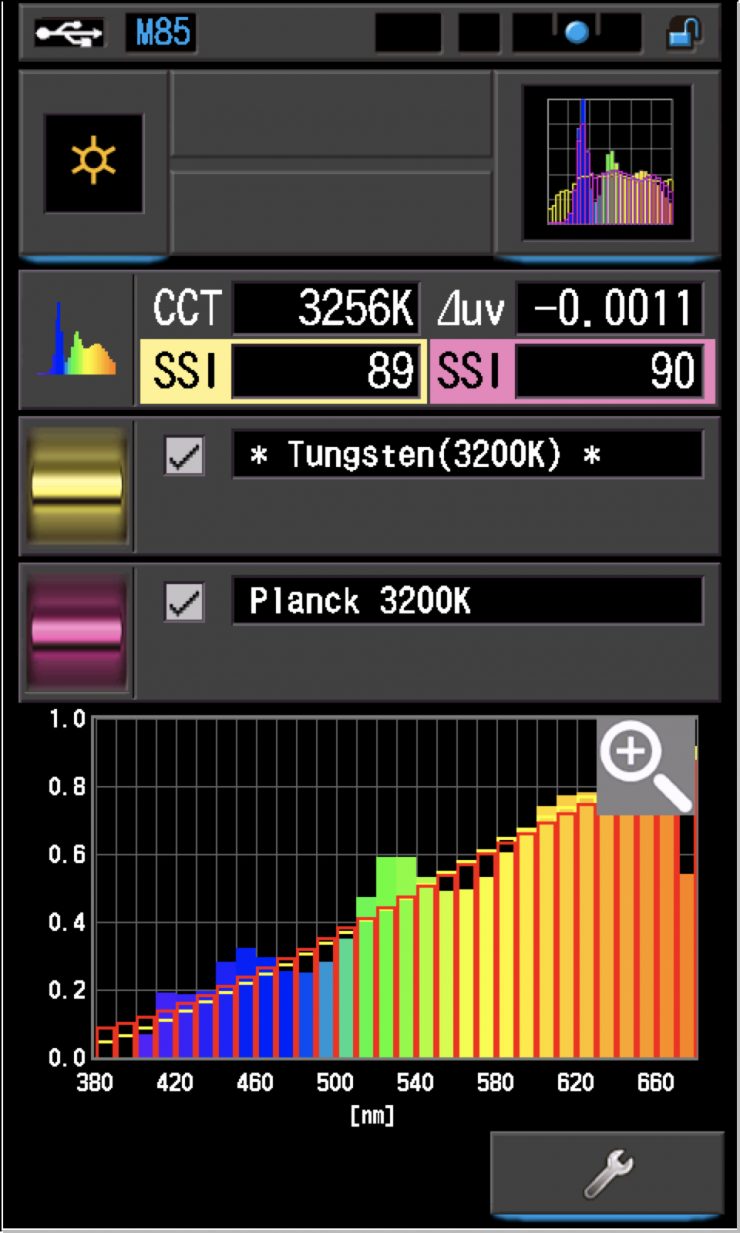
In this graph, the red bars indicate a perfect Planck 3200K source. The gold bars indicate a perfect 3200K Tungsten source. This lets us compare how close to a perfect 3200K lighting source the Vega 30C is. Any SSI score in the low ’80s is very good for a 3200K LED light. What this showed me is that the SSI scores remain unchanged from the original firmware. Again, these are the best SSI scores I have seen for any LED light when used at 3200K.
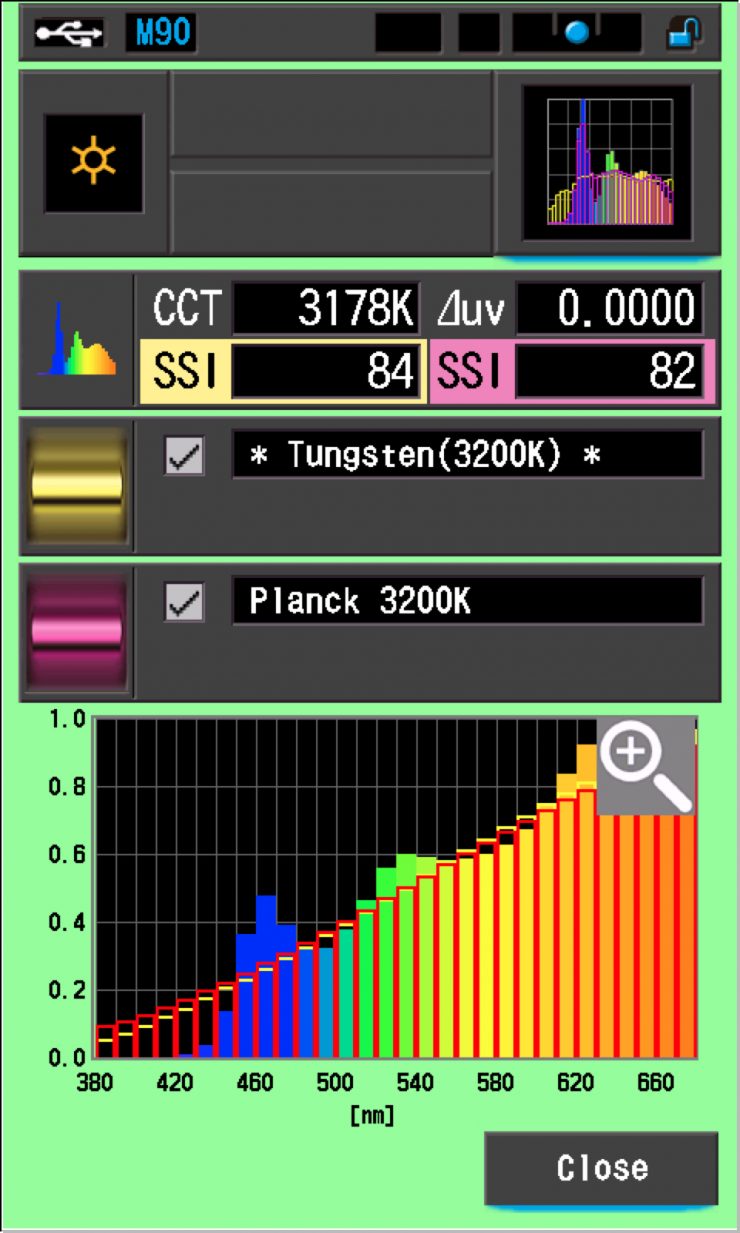
As a reference, above you can see the same result for the Rotolight Titan X1.
5600K
ZOLAR Toliman 30C 5600K (Original Firmware)
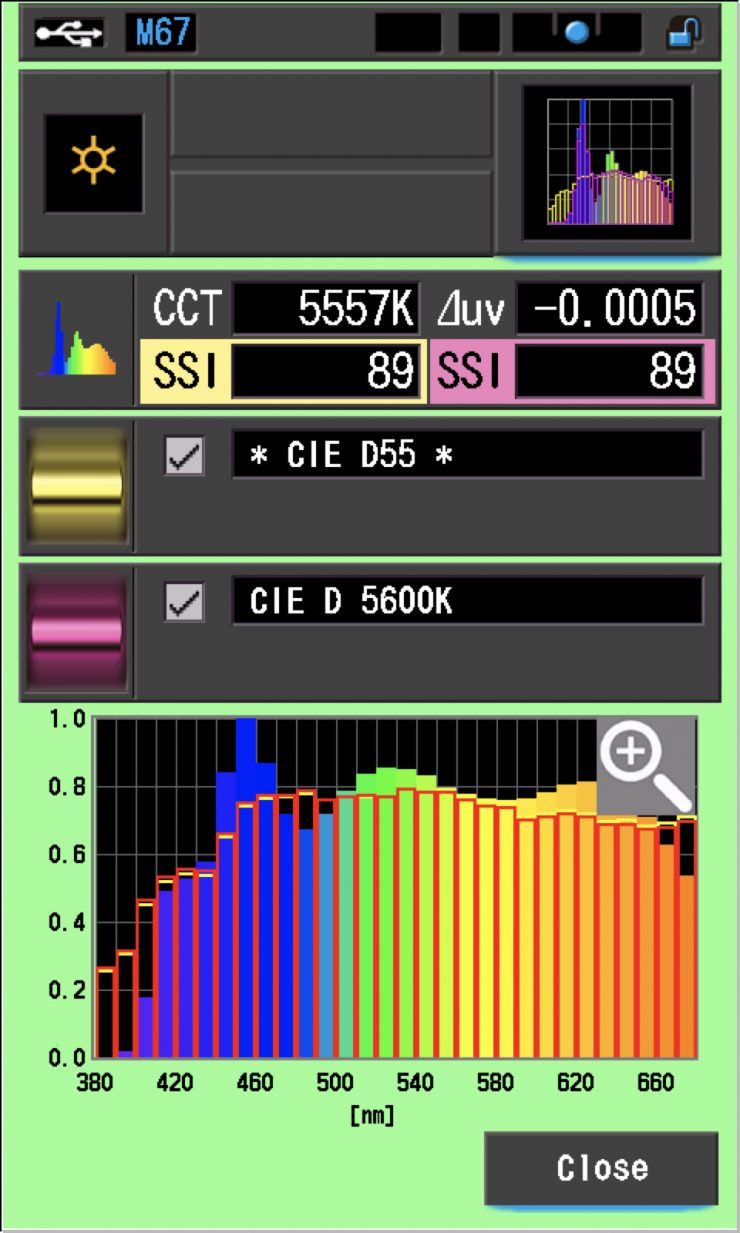
In the graph above the gold bars indicate a perfect CIE D55 source. The red bars indicate a perfect CIE D 5600K source. This lets us compare how close to a perfect 5600K lighting source the Vega 30C is. A score in the low 70’s is typical for a 5600K LED source. A score of 89 is ridiculously good.
ZOLAR Toliman 30C 5600K (New Firmware)
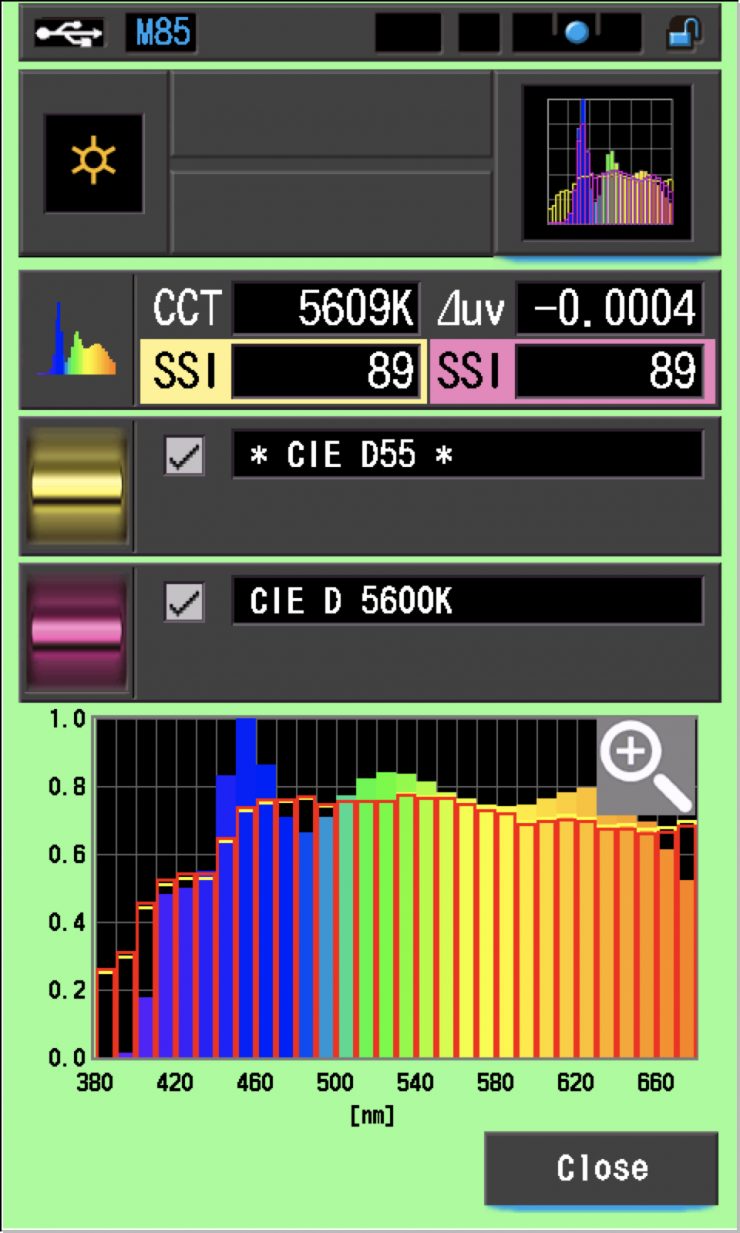
In the graph above the gold bars indicate a perfect CIE D55 source. The red bars indicate a perfect CIE D 5600K source. This lets us compare how close to a perfect 5600K lighting source the Vega 30C is. A score in the low 70’s is typical for a 5600K LED source. A score of 89 is ridiculously good. Again, there is no change to the SSI scores with the new firmware.

As a reference, above you can see the same result for the Rotolight Titan X1.
SSI Comparisons
The main reason we want to record SSI scores is so we can see how well they match with other lights. Now here is where things become difficult. Because the ZOLAR lights have such high SSI scores they are not going to match other lights nearly as well, particularly at 5600K. As an example, I will show you how well the Vega 30C running its original firmware matched an ARRI Orbiter and Luxli’s Timpani 2. Below you can see the results when the lights are set at both 5600K and 3200K.
3200K (original firmware)
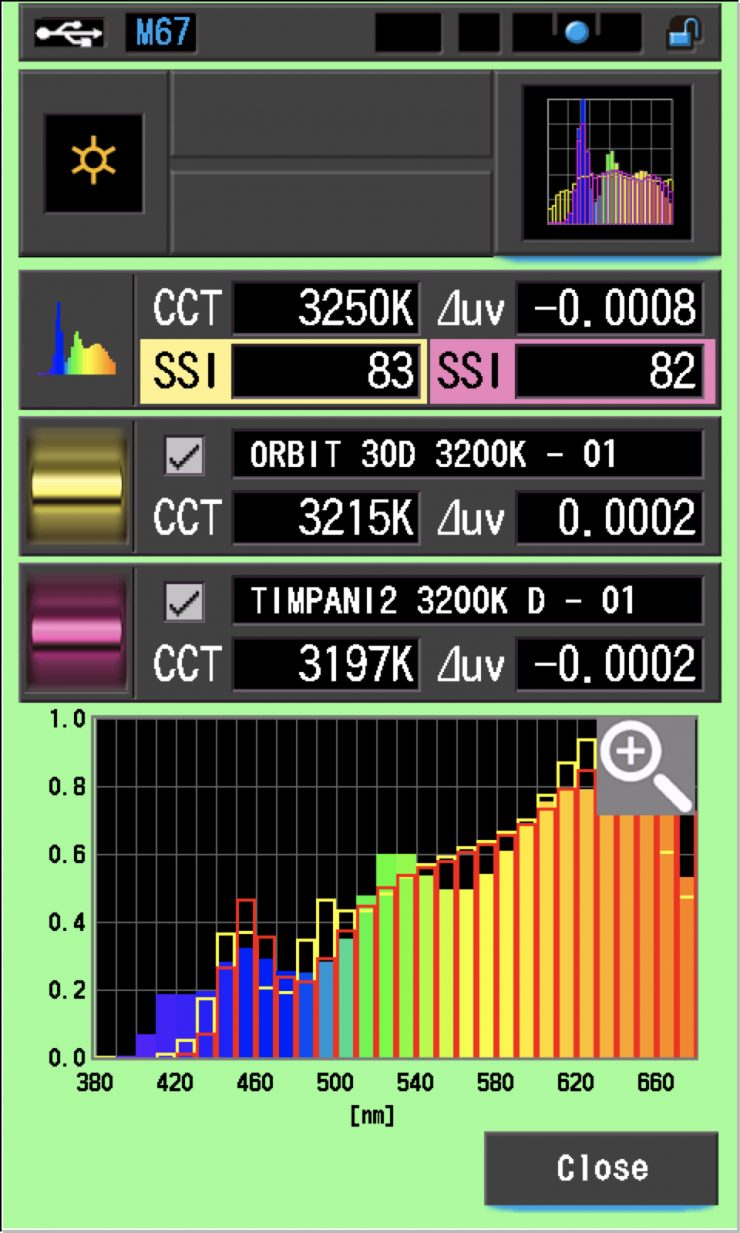
As you can see the ARRI and the Luxli are not that close to being a perfect match to the Vega 30C at 3200K, although with a bit of fine-tuning you could probably get them to work together without any big issues. A score of 80 is still pretty reasonable.
3200K (New firmware)
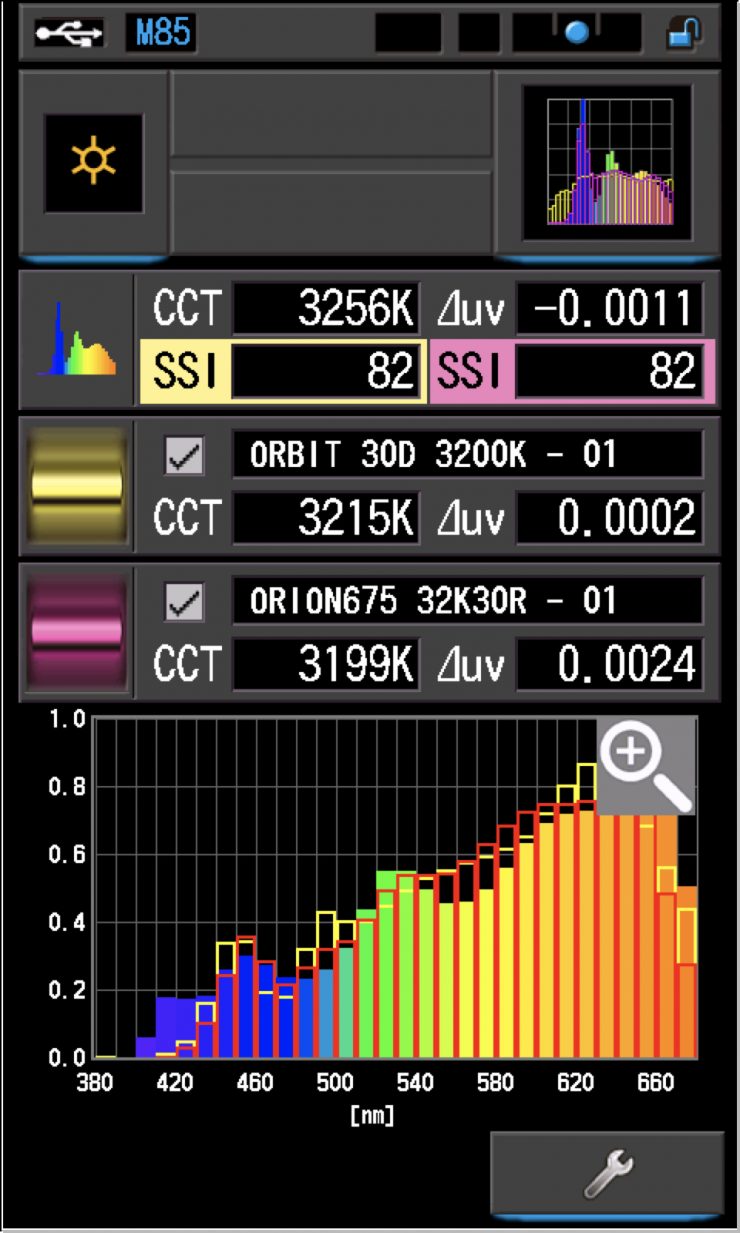
Above you can see how well the Vega 30C running its new firmware matched an ARRI Orbiter and the Prolycht Orion 675 FS. As you can see, neither light is a very good match to the Vega 30C.
5600K (Original firmware)
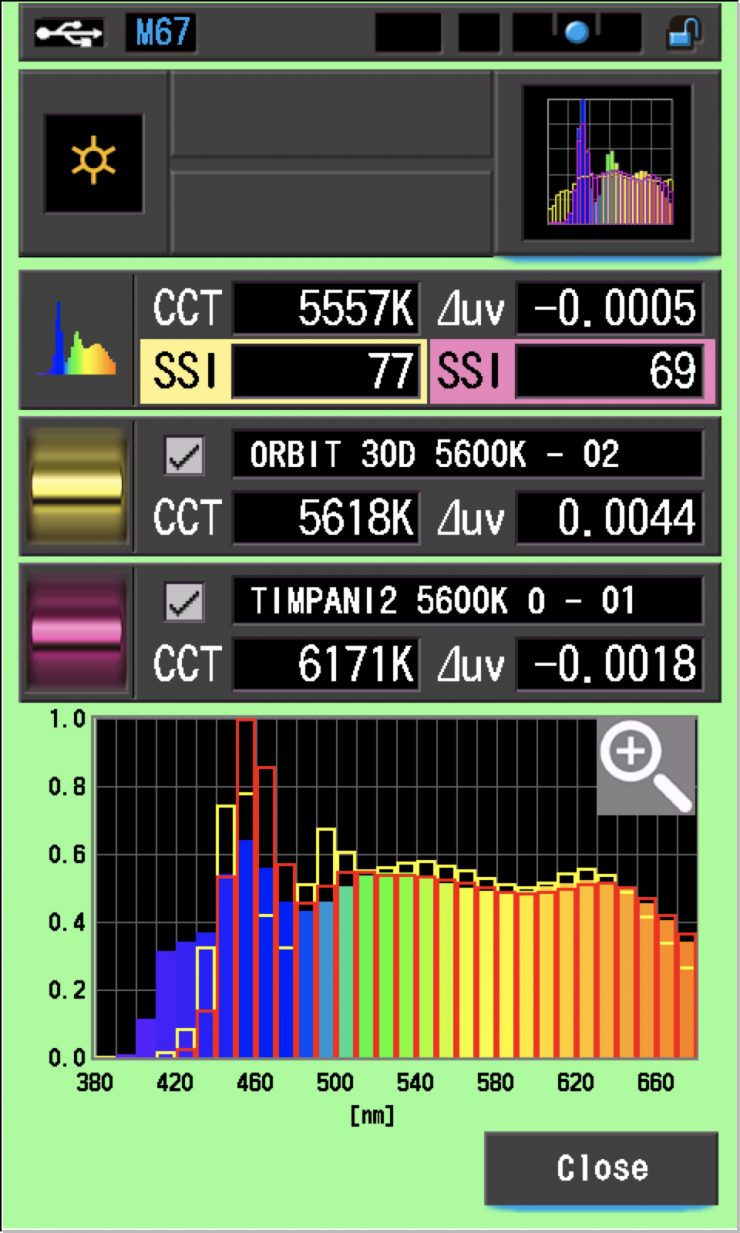
Here is where things get interesting. At 5600K both the ARRI and the Luxli are way off being anywhere near a perfect match to the Vega 30C.
5600K (New firmware)
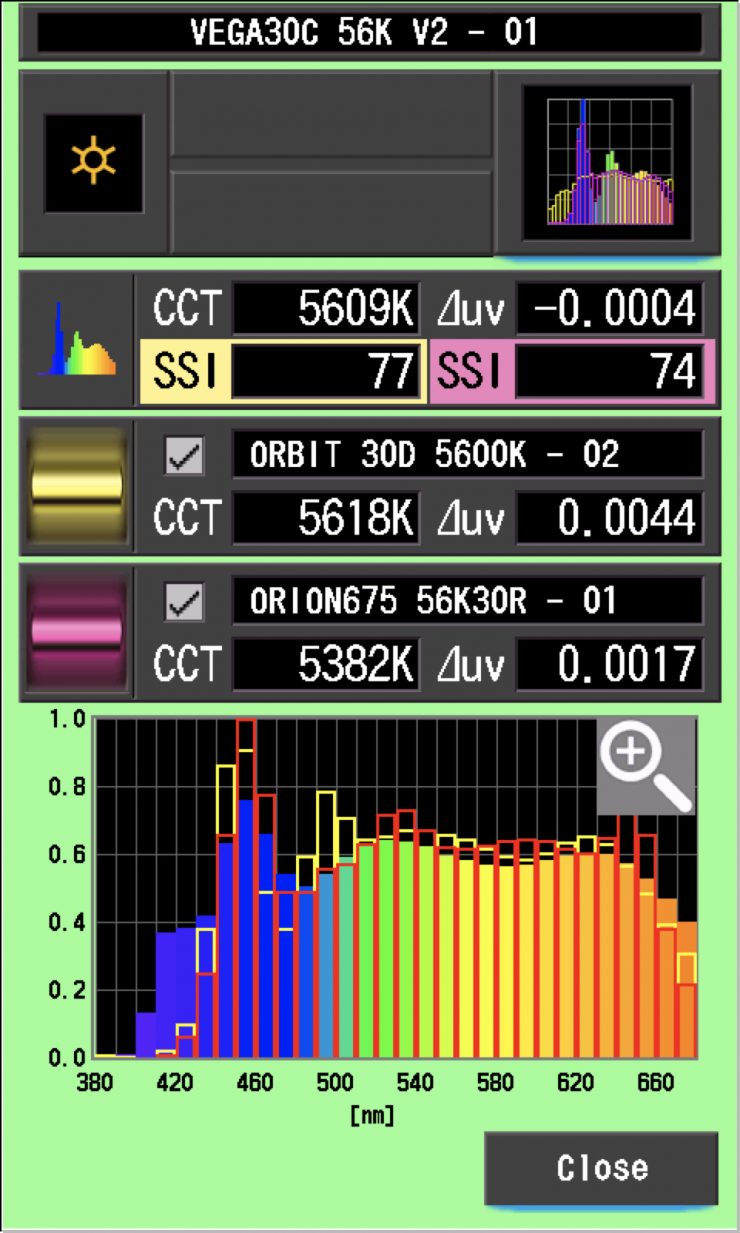
At 5600K both the ARRI and the Prolycht are way off being anywhere near a perfect match to the Vega 30C.
Because the SSI scores at 5600K are so much different from other lights, let’s see how well the Vega 30C matches Z CAM’s other ZOLAR fixtures, the Toliman 30C and Toliman 30S. What is interesting is that the Vega 30C has a Toliman matching mode setting in its menu and you can select this if you want to use the Vega with those other lights to get them to more closely match. So let’s see if that actually works or is it a gimmick? (Color matching mode will be added to other ZOLAR series via a firmware update).
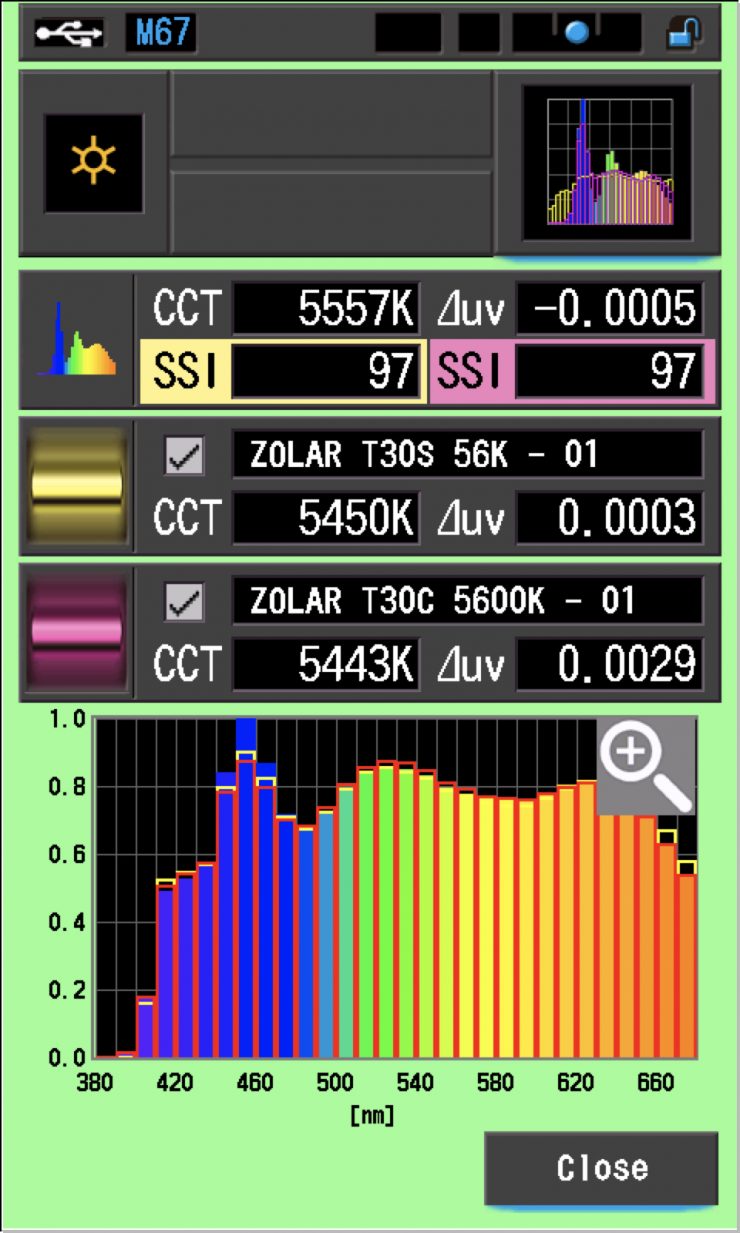
Above you can see how well the Vega 30C matches the Toliman 30C and Toliman 30S when it is used in its default configuration at 5600K. As you can see these lights are almost a perfect match when used at 5600K.
Ok, so let’s see if setting the Vega 30C to its Toliman match setting makes any difference.
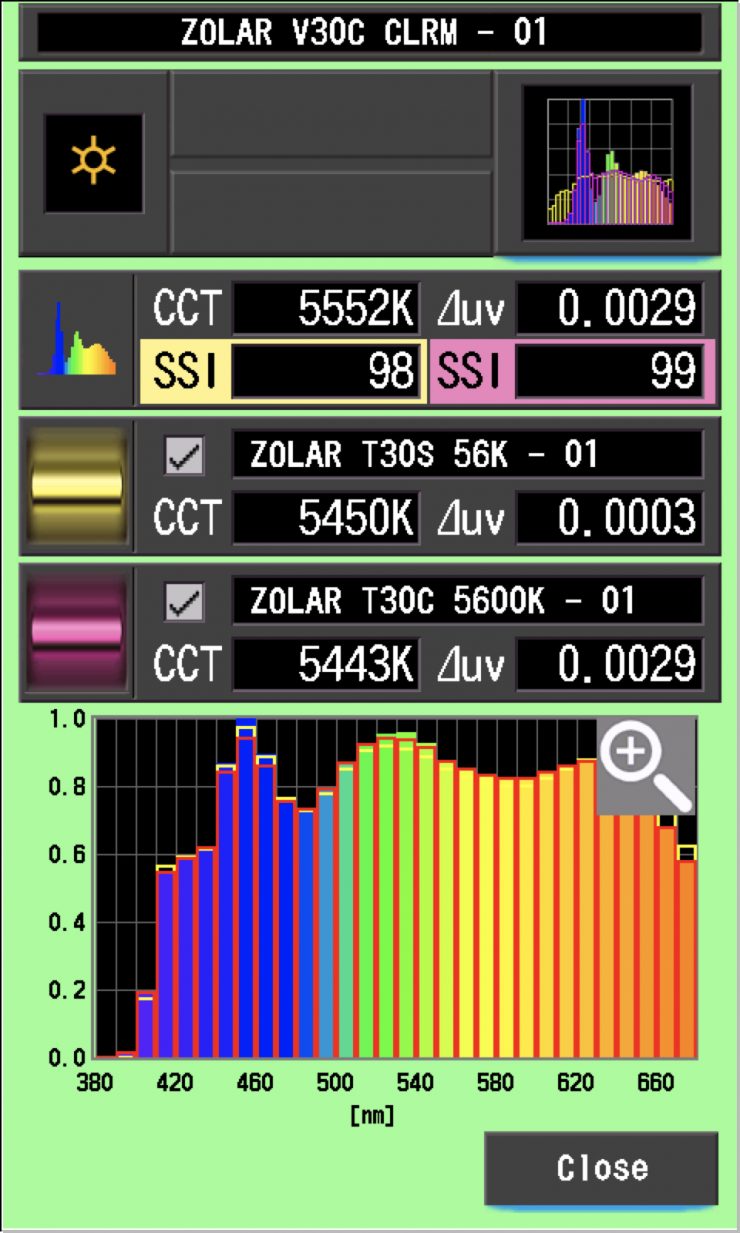
Above you can see how well the Vega 30C matches the Toliman 30C and Toliman 30S when it is used in its Toliman match configuration at 5600K. As you can see the scores did improve. In particular, the Toliman 30C is almost an identical match to the Vega 30C with a score of 99.
I am really impressed with what ZOLAR has done here. Putting a feature inside one of your lights to help it more closely match other fixtures in your range is a smart move.
SSI tests are a great way of telling you what lights you own or use will work well together.
Spectral Distribution
ZOLAR Vega 30C 5600K (Original firmware)
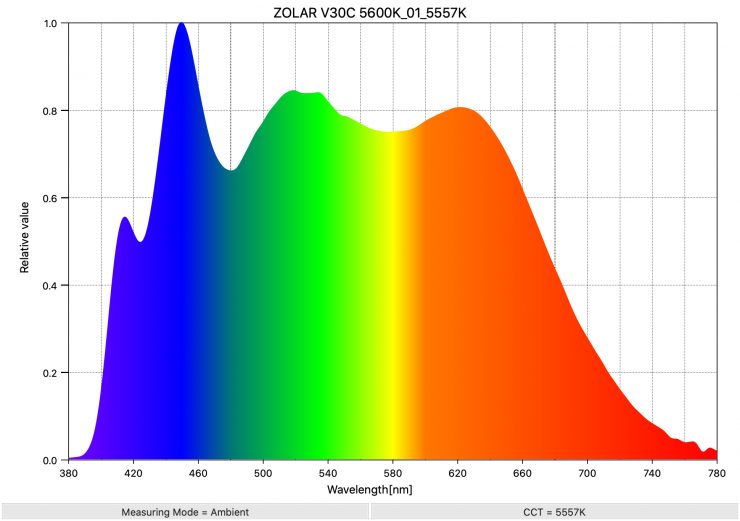
Above you can see the spectral distribution of the Vega 30C when set at 5600K. The spectral distribution is exceptionally good at 5600K. This spectral distribution is far better than any LED light I have ever tested at 5600K, except for the Toliman 30C.
ZOLAR Vega 30C 5600K (Original firmware)
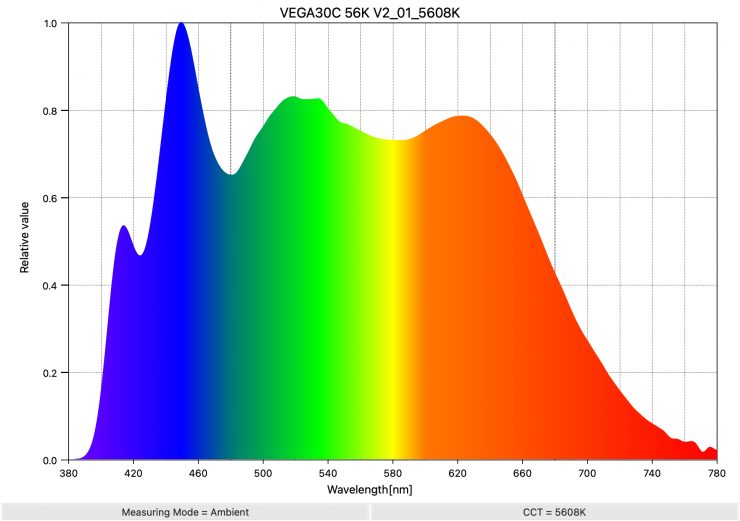
Above you can see the spectral distribution of the Vega 30C running its new firmware when set at 5600K. The spectral distribution is exceptionally good at 5600K. Again, this spectral distribution is far better than any LED light I have ever tested at 5600K, except for the Toliman 30C.
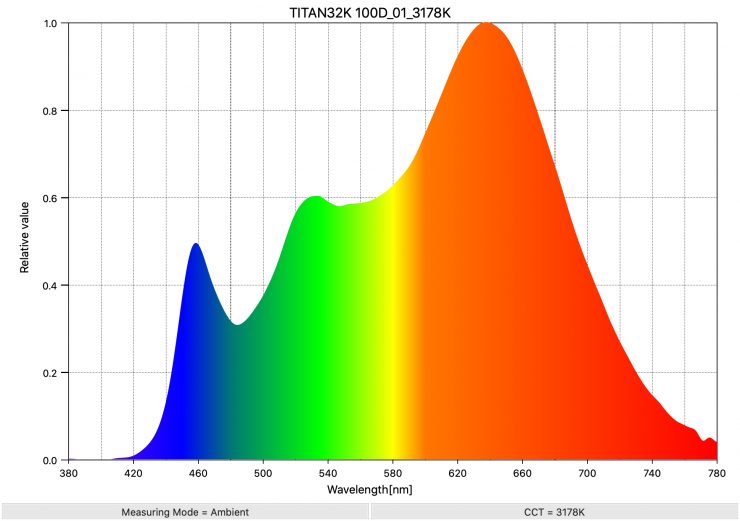
As a reference, above you can see the spectral distribution for the Rotolight Titan X1.
ZOLAR Vega 30C 3200K (Original firmware)
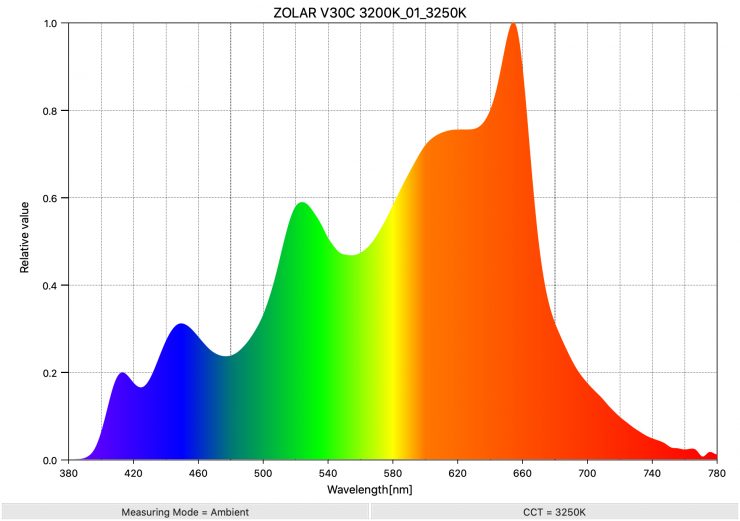
Strangely the spectral distribution for the Vega 30C, when used at 3200K, was a bit all over the place. There was quite a pronounced green spike in the spectrum as well as a lot of missing information.
ZOLAR Vega 30C 3200K (New firmware)
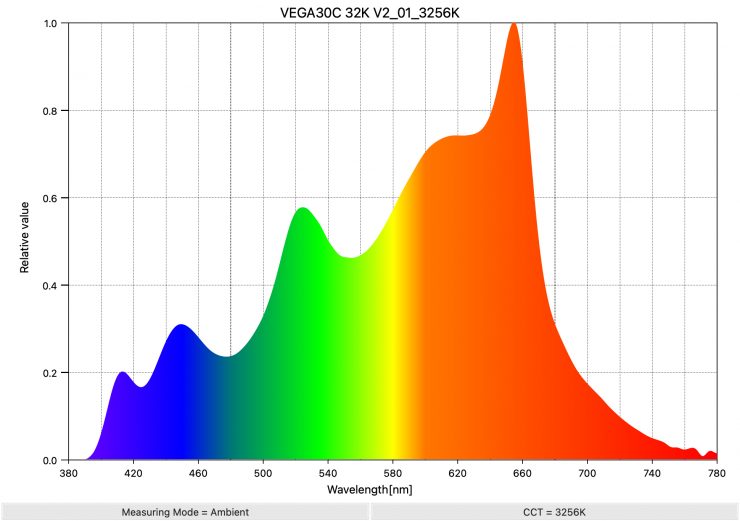
As you can see, the spectral response remains exactly the same with the new firmware.
So what did we learn?
The firmware update managed to squeeze slightly more output from the light and it did improve the accuracy of some of the CCT settings.
It is nice to see that Z CAM just didn’t release a light and then wash their hands with it. I have reviewed so many lights where manufacturers promise firmware updates in the future that never come.
The Z CAM Vega 30C, as I mentioned at the top of this article, is by far the best value and best-performing 1×1 RGB light on the market and it isn’t even close.
Price & Availability

The Z CAM ZOLAR Vega 30C (5-color LED) retails for $799.00 USD.
The ZOLAR series is very competitively priced.
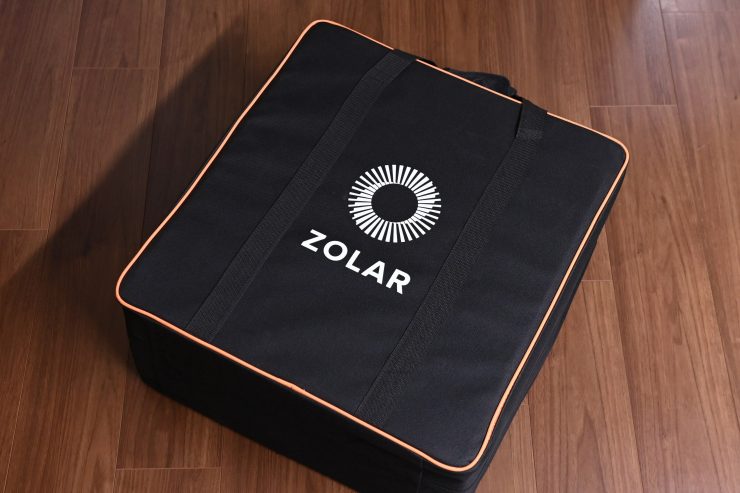
The light comes in a soft case that has foam cutouts inside.
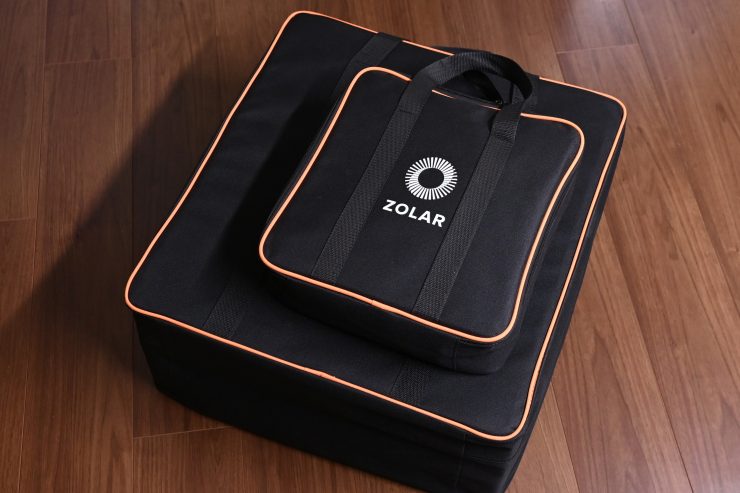
With the Vega 30C, you get an extra bag that is for the power supply. I would have preferred to have seen a solution where everything fits into one bag. It would have also been nice to have seen some optional hard cases for those people who want to travel and fly with the lights.
Below you can see how the price of the Vega 30C compares to other 1×1 RGBW lights on the market:
| Price | |
| Z CAM ZOLAR Vega 30C | $799 USD |
| Luxli Timpani² | $999 USD |
| Creamsource Vortex4 1×1 RGBW | $2,799 USD |
| Rotolight Titan X1 | $3,529 USD |
| ARRI SkyPanel S30-C | $4,900 USD |
| Litepanels Gemini 1×1 | $1,990.25 USD |
| Litepanels Gemini 1 x 1 RGBWW LED Hard Panel | $1,997.50 USD |
| Lupo Superpanel Soft Full Color 30 | $1,698 USD |
| Lupo Superpanel Full Color 30 | $1,698 USD |
| VELVETlight Evo 1 Studio 1×1 Color-Tunable LED Panel | $2,776.75 USD |
| Rayzr 7 MC120 | $744 USD |
| Luxli Timpani 1×1 RGBAW | $849.99 USD |
| Aputure NOVA P300c | $1,699 USD |
| TRIGYN Vari-Light RGBW 1×1 LED Soft Light Kit | $919 USD |
| Falcon Eyes D-S811 RGB 1×1 | $1,299 USD |
| Fluotec Cinelight Color30 1X1 Color | $1,643 USD |
With modern-day lights (and this goes for just about any of today’s technology) the lifespan of the product is not going to be as long. That is not to say your light will become obsolete in 3 years time, but there will be something better that is bound to come along.
In saying that, a lot of today’s lights are receiving new features via firmware updates. This is something that increases their flexibility and feature set.
The Z CAM ZOLAR Vega 30C is an absolute bargain compared to the competition. It is well made, fully featured, has a good amount of output, and it has color rendering scores that other lights can’t beat.





